





6.
SUMMARY OF
MONITORING EXCEEDANCE, COMPLAINTS, NOTIFICATION OF SUMMONS AND
PROSECUTIONS................................................................................................................................................................ 20
Appendix A Master Programme
Appendix B Overview of Desalination Plant in Tseung Kwan O
Appendix C Summary of Implementation Status of Environmental
Mitigation
Appendix D Impact Monitoring Schedule of the Reporting Month (Blank)
Appendix E Event/Action Plan for Noise Exceedance
Appendix F Noise Monitoring Equipment Calibration Certificate (Blank)
Appendix G Event/Action Plan for Water Quality Exceedance
Appendix H Waste Flow Table
Appendix I Site Inspection Proforma
Appendix J Complaint Log
Appendix K Impact Monitoring Schedule of Next Reporting Month (Blank)
INTRODUCTION
A1. The Project, Design, Build and Operate First Stage of Tseung Kwan O Desalination Plant (TKODP), is a Designated Project under the Environmental Impact Assessment Ordinance (Cap. 499) (EIAO) and is currently governed by a Further Environmental Permit (EP No. FEP- 01/503/2015/A) for the construction and operation of the Project.
A2. In accordance with the Updated Environmental Monitoring and Audit (EM&A) Manual for the Project, EM&A works for marine water quality, noise, waste management and ecology should be carried out by Environmental Team (ET), Acuity Sustainability Consulting Limited (ASCL), during the construction phase of the Project.
A3. This is the 9th Monthly EM&A Report, prepared by ASCL, for the Project summarizing the monitoring results and audit findings of the EM&A programme at and around Tseung Kwan O Area 137 (TKO 137) during the reporting period from 1 November 2020 to 30 November 2020.
A4. The EM&A programme for this contract has covered environmental monitoring on construction noise level at selected NSRs and Contractor��s environmental performance auditing in the aspects of construction dust, construction noise, water quality, waste management, Landscape and Visual and Ecology.
SUMMARY
OF MAIN WORKS UNDERTAKEN & KEY MITIGATION MEASURES IMPLEMENTED
A5. Key activities carried out in this reporting period for the Project included the followings:
- Land Survey;
- Access Road Construction;
- Construction of 132kV substation;
- Construction of ActiDAFF footing and perimeter wall;
- Construction of RO/electrical building footing and ground floor slab;
- Construction for Product Water Storage Tank footing;
- Excavation and Installation of temporary soil nail at Product Water Storage Tank;
- Excavation and ELS installation for combine shaft;
- Installation of socketed H pile at admiration building.
A6. The major environmental impacts brought by the above construction works include:
- Construction dust and noise generation from the ground investigation works, access road construction, pre-boring and installation of sheetpiles and excavation works
- Waste generation from the construction activities
A7. The key environmental mitigation measures implemented for the Project in this reporting period associated with the above construction works include:
- Dust suppression by regular wetting and water spraying for construction works
- Reduction of noise from equipment and machinery on-site
- Sorting and storage of general refuse and construction waste
SUMMARY
OF EXCEEDANCE
& INVESTIGATION
& FOLLOW-UP
A8. No noise monitoring was conducted during the reporting period since there are no project- related construction activities undertaken within a radius of 300m from the monitoring locations. No project-related exceedance of the Action Level was recorded during the reporting period.
A9. No water quality monitoring was conducted in the reporting month since the commencement of marine construction and dredging activities for the Project are scheduled in January 2020 the earliest. No project-related exceedance of the Action Level was recorded during the reporting period.
A10. Weekly site inspections of the construction work by ET were carried out on 3, 10, 18 & 26 November 2020 to audit the mitigation measures implementation status. Bi-weekly joint site inspection was carried out on 10 & 26 November 2020 by ET and IEC. Observations were recorded in the site inspection checklists and provided to the contractors together with the appropriate follow-up actions where necessary.
COMPLAINT
HANDLING
AND PROSECUTION
A11. No project-related environmental complaint was received during the reporting period.
A12. Neither notifications of summons nor prosecution was received for the Project.
REPORTING
CHANGE
A13. There was no change to be reported that may affect the on-going EM&A programme.
SUMMARY
OF UPCOMING
KEY ISSUES AND KEY MITIGATION MEASURES
A14. Key activities anticipated in the next reporting period for the Project will include the following:
- Land Survey;
- Access Road Construction;
- ELS installation and bulk excavation at combine shaft;
- Construction of 132kV substation (roof) and internal finishing;
- Construction of ActiDAFF footing and perimeter wall;
- Construction of RO/electrical building footing and ground floor slab;
- Construction for Product Water Storage Tank footing and perimeter wall;
- Excavation for post treatment building
- Installation of socketed H pile at admiration building
- Excavation for 11kV substation
A15. The major environmental impacts brought by the above construction works will include:
- Construction dust and noise generation from GI works, access road construction, excavation works and installation of ELS;
- Waste generation from construction activities
A16. The key environmental mitigation measures for the Project in the coming reporting period associated with the above construction works will include:
- Dust suppression by regular wetting and water spraying for construction works
- Reduction of noise from equipment and machinery on-site
- Sorting and storage of general refuse and construction waste
1.1.
BACKGROUND
The Jardine Engineering Corporation, Limited, China State Construction Engineering (Hong Kong) Limited and Acciona Agua, S.A. Trading As AJC Joint Venture (AJCJV) is contracted to carry out the Design, Build and Operate First Stage of Tseung Kwan O Desalination Plant (DPTKO) under Contract No. 13/WSD/17 (the Project).
Acuity Sustainability Consulting Limited (ASCL) is commissioned by AJCJV to undertake the Environmental Team (ET) services as required and/or implied, both explicitly and implicitly, in the Environmental Permit (EP), Environmental Impact Assessment Report (EIA Report) (Register No. AEIAR-192/2015) and Environmental Monitoring and Audit Manual (EM&A Manual) for the Project; and to carry out the Environmental Monitoring and Audit (EM&A) programme in fulfillment of the EIA Report��s EM&A requirements and Contract No. 13/WSD/17 Specification requirements.
Pursuant to the Environmental Impact Assessment Ordinance (EIAO), the Director of Environmental Protection granted the Environmental Permit (No. EP-01/503/2015) and Variation of Environmental Permit (No. EP-01/503/2015/A) to Water Supplies Department (WSD); and granted the Further Environmental Permit (No. FEP-01/503/2015/A) to AJCJV for the Project.
1.2.
THE REPORTING SCOPE
This is the 9th Monthly EM&A Report for the Project which summarizes the key findings of the EM&A programme during the reporting period from 1 November to 30 November 2020.
1.3.
PROJECT ORGANIZATION
The Project Organization structure for Construction Phase is presented in Figure 1.1.

Figure 1.1 Project
Organization Chart
Contact details of the key personnel are presented in Table 1.1 below:
Table 1.1 Contact
Details of Key Personnel
|
Party |
Position |
Name |
Telephone
no. |
|
Project Proponent |
SE/CM2 |
Benny Lam |
2634-3573 |
|
Supervising Officer (Black & Veatch) |
Project Manager |
Christina Ko |
2608-7302 |
|
Chief Resident Engineer |
Roger Wu |
6343-1002 |
|
|
The Jardine Engineering Corporation, Limited, China State Construction Engineering (Hong Kong) Limited and Acciona Agua, S.A. Trading |
Project Manager |
Stephen Yeung |
2807-4665 |
|
Environmental Monitoring Manager |
Brian Kam |
9456-9541 |
|
|
Acuity Sustainability Consulting Limited |
Environmental Team Leader |
Jacky Leung |
2698-6833 |
|
ANewR Consulting Limited |
Independent Environmental Checker (IEC) |
Adi Lee |
2618-2831 |
1.4.
SUMMARY OF CONSTRUCTION WORKS
Details of the major construction activities undertaken in this reporting period are shown in below. The construction programme is presented in Appendix A.
Key activities carried out in this reporting period for the Project included the following:
- Land Survey;
- Access Road Construction;
- Construction of 132kV substation;
- Construction of ActiDAFF footing and perimeter wall;
- Construction of RO/electrical building footing and ground floor slab;
- Construction for Product Water Storage Tank footing;
- Excavation and Installation of temporary soil nail at Product Water Storage Tank;
- Excavation and ELS installation for combine shaft;
- Installation of socketed H pile at admiration building.
1.5.
SUMMARY OF ENVIRONMENTAL STATUS
A summary of the valid permits, licences, and /or notifications on environmental protection for this Project is presented in Table 1.2.
Table 1.2 Summary
of the Status of Valid Environmental Licence, Notification, Permit and Documentations
|
Permit/
Licenses/ Notification |
Reference |
Validity Period |
Remarks |
|
Environmental Permit |
FEP
- 01/503/2015/A |
Throughout the Contract |
|
|
Notification
of Construction Works under the Air Pollution Control (Construction Dust)
Regulation (Form NA) |
Ref.
No.: 451539 |
30/12/2019
- 30/03/2023 |
|
|
Wastewater Discharge Licence |
WT00035775-2020 |
24/07/2020
- 31/07/2025 |
|
|
Chemical Waste Producer Registration |
5213-839-A2987-01 |
Throughout the Contract |
|
|
Construction Noise Permit (24 hours) |
GW-RE0474-20 |
04/06/2020
- 03/12/2020 |
|
|
Construction Noise Permit (24 hours) |
GW-RE0784-20 |
01/10/2020
- 31/03/2021 |
|
|
Billing Account for Disposal of Construction Waste |
7036276 |
Throughout
the Contract |
|
The status for all environmental aspects is presented in Table 1.3.
Table 1.3 Summary
of Status for Key Environmental Aspects under the Updated EM&A Manual
|
Parameters |
Status |
|
Water Quality |
|
|
Baseline Monitoring under EM&A Manual |
The baseline water quality monitoring was conducted between 12 May 2020 to 6 Jun 2020 |
|
Impact Monitoring |
The impact water quality monitoring has been scheduled after the commencement of marine construction works |
|
Noise |
|
|
Baseline Monitoring |
The baseline noise monitoring result has been reported in Baseline Monitoring Report and submitted to EPD under EP Condition 3.4 |
|
Impact Monitoring |
On-going |
|
Waste Management |
|
|
Mitigation Measures in Waste Monitoring Plan |
On-going |
|
Environmental Audit |
|
|
Site Inspection covering Measures of Air Quality, Noise Impact, Water Quality, Waste, Ecological Quality, Fisheries, Landscape and Visual |
On-going |
The impact monitoring schedule for the reporting month to be shown at Appendix D is intentionally left blank since no impact monitoring was conducted in the reporting month.
Other than the EM&A work by ET, environmental briefings, trainings and regular environmental management meetings were conducted, in order to enhance environmental awareness and closely monitor the environmental performance of the contractors.
The EM&A programme has been implemented in accordance with the recommendations presented in the approved EIA Report and the EM&A Manual. A summary of implementation status of the environmental mitigation measures for the construction phase of the Project during the reporting period is provided in Appendix C.
2.1.
MONITORING REQUIREMENTS
To ensure no adverse noise impact, noise monitoring is recommended to be carried out within 300m radius from the nearby noise sensitive receivers (NSRs), during construction phase. The NSRs selected as monitoring station are (i) NSR4 - Creative Secondary School, (ii) NSR24 - PLK Laws Foundation College, and (iii) NSR31 - School of Continuing and Professional Studies - CUHK respectively.
In accordance with the EM&A Manual, baseline noise level at the noise monitoring stations were established as presented in the Baseline Monitoring Report. Impact noise monitoring will be conducted once per week in the form of 30-minutes measurements Leq, L10 and L90 levels recorded at each monitoring station between 0700 and 1900 hours on normal weekdays.
Referring to EM&A manual Section 4.1.2, the impact noise monitoring should be carried out at all the designated monitoring stations when there are project-related construction activities undertaken within a radius of 300m from the monitoring stations.
No impact monitoring for noise impact was conducted in the reporting month due to the overly distant monitoring station from the works location, where they were farther than 1 km from the closet monitoring station NSR4 to the works location.
Impact noise monitoring will be conducted weekly in the reporting period between 0700-1900 on normal weekdays. No construction works were carried out during 1900-0700 in all days or any time on Sundays or general holidays during the reporting period.
Construction noise level measured in terms of the A-weighted equivalent continuous sound pressure level (LAeq). Leq 30min was used as the monitoring parameter for the time period between 0700 and 1900 on normal weekdays. Table 2.1 summarizes the monitoring parameters, frequency and duration of the impact noise monitoring.
Table 2.1 Noise
Monitoring Parameters, Time, Frequency and Duration
|
Time |
Duration |
Interval |
Parameters |
|
Daytime:
0700-1900 |
Day time: 0700-1900 (during normal weekdays) |
Continuously in Leq 5min/Leq 30min (average of 6 consecutive
Leq 5min) |
Leq 30min L10 30min & L90 30min |
2.2.
MONITORING LOCATIONS
The monitoring locations should normally be made at a point 1m from the exterior of the NSRs building façade and be at a position 1.2m above the ground. A correction of +3dB(A) should be made to the free-field measurements.
According to the environmental findings detailed in the EIA report and Baseline Monitoring Report, the designated locations for the construction noise monitoring are listed in Table 2.2 below.
Table 2.2 Noise
Sensitive Receivers
|
NSR ID |
Noise Sensitive Receivers |
Monitoring Location |
Position |
|
NSR 4 |
Creative
Secondary School |
Roof
Floor |
1
m from facade |
|
NSR 24 |
PLK Laws
Foundation College |
Pedestrian Road on
Ground Floor |
Free-field |
|
NSR 31 |
School of Continuing
and Professional Studies - CUHK |
Roof
Floor |
1
m from facade |
The monitoring locations should normally be made at a point 1m from the exterior of the NSRs building façade and be at a position 1.2m above the ground. A correction of +3dB(A) should be made to the free-field measurements. Three noise monitoring locations for impact monitoring at the nearby sensitive receivers are shown in Figure 2.1-2.3.
|
|
|
|
|
|
Figure 2.1 NSR4 Creative Secondary
School |
|
|
|
|
|
|
|
Figure 2.2 NSR24 PLK Laws Foundation
College |
|
|
|
|
|
||
|
|
Figure 2.3
NSR31 School of Continuing
and Professional Studies - CUHK |
|
|
|
2.3.
IMPACT MONITORING METHODOLOGY
Integrated sound level meter shall be used for the noise monitoring. The meter shall be in compliance with the International Electrotechnical Commission Publications 651: 1979 (Type 1) and 804: 1985 (Type 1) specifications. Immediately prior to and following each noise measurement the accuracy of the sound level meter shall be checked using an acoustic calibrator generating a known sound pressure level at a known frequency. Measurements may be accepted as valid only if the calibration levels before and after the noise measurements agree to within 1.0 dB(A). Calibration certificates of the instruments used to be shown at Appendix F are intentionally left blank since no impact monitoring equipment was used in the reporting month.
Noise measurements shall not be made in the presence of fog, rain, wind with a steady speed exceeding 5 m/s or wind with gusts exceeding 10 m/s. The wind speed shall be checked with a portable wind speed meter capable of measuring the wind speed in m/s.
Table 2.3 Impact
Noise Monitoring Equipment
|
Equipment |
Brand and Model |
Detection Limit |
|
Sound Level Meter |
Nti XL2 |
30-130 dB(A) |
|
Sound Level Meter Calibrator |
Rion NC-74 |
Nil |
|
Pocket Wind Meter Anemometer |
Kestrel 1000 Wind Meter |
Nil |
2.4.
ACTION AND LIMIT LEVELS
The Action/Limit Levels are in line with the criteria of Practice Note for Professional Persons (ProPECC PN 2/93) ��Noise from Construction Activities - Non-statutory Controls�� and Technical Memorandum on Environmental Impact Assessment Process issued by HKSAR Environmental Protection Department [��EPD��] under the Environmental Impact Assessment Ordinance, Cap 499,
S.16 are presented in Table 2.4.
Table 2.4 Action
and Limit Levels for Noise per Updated EM&A Manual
|
Time Period |
Action |
Limit (dB(A)) |
|
0700-1900
on normal weekdays |
When one documented complaint is
received from any one of the noise sensitive receivers |
�P
70
dB(A) for school and �P
65
dB(A) during examination period |
Notes: Limits
specified in the GW-TM and IND-TM for construction and operation noise,
respectively.
If exceedances were found during noise monitoring, the actions in accordance with the Event and Action Plan shall be carried out according to Appendix E.
2.5.
MONITORING RESULTS AND
OBSERVATIONS
Referring to EM&A manual Section 4.1.2, the impact noise monitoring should be carried out when there are project-related construction activities undertaken within a radius of 300m from the monitoring stations. No monitoring station was located within a radius of 300m of the Project site as shown in Figure 2.4, no impact monitoring for noise impact was conducted in the reporting period.

Figure 2.4 Site Layout
Plan with Noise Sensitive Receivers and Desalination Plant
.
3.
WATER QUALITY
In accordance with the recommendations of the EIA, water quality EM&A is required during dredging for the submarine pipelines and, during operation phase. In addition, baseline water quality monitoring will be required prior to the commencement of marine construction activities. The following Section provides details of the water quality monitoring to be undertaken by the Environmental Team (ET) to verify the distance of sediment and brine plume dispersion and to identify whether the potential exists for any indirect impacts to occur to ecological sensitive receivers. The water quality monitoring programme will be carried out to allow any deteriorating water quality to be readily detected and timely action taken to rectify the situation. The status and locations of water quality sensitive receivers and the marine works location may change after issuing this Document. If required, the ET in consultation with IEC will propose updated monitoring locations and seek approval from EPD.
Water quality monitoring for the Project can be divided into the following stages:
-
Dredging
activities during construction phase;
-
Discharge
of effluent from main disinfection during construction phase;
-
Operation
phase - first year upon commissioning; and,
-
Continuous
monitoring of effluent quality.
In addition, the marine works contractor is required to complete a silt curtain efficiency test for the combined use of floating silt curtain type and cage type silt curtain for dredging at seawater intake to confirm the silt curtain reduction efficiency assumptions of the assessment. The details of testing plan together with the silt curtain deployment plan updated testing plan shall be submitted by the ET to seek approval from the IEC and EPD.
3.1.
IMPACT MONITORING METHODOLOGY
3.1.1. WATER QUALITY PARAMETERS
The parameters that have been selected for measurement in situ and in the laboratory are those that were either determined in the EIA to be those with the most potential to be affected by the construction works or are a standard check on water quality conditions. Parameters to be measured in the baseline monitoring are listed in Table 3.1.
Table 3.1 Parameters
measured in the baseline marine water quality monitoring
|
Parameters |
Unit |
Abbreviation |
|
In-situ measurements |
||
|
Dissolved
oxygen |
mg/L |
DO |
|
Temperature |
oC |
- |
|
pH |
- |
- |
|
Turbidity |
NTU |
- |
|
Salinity |
0/00 |
- |
|
Total
Residual Chlorine NOTE1 |
mg/L |
TRC |
|
Laboratory measurements |
||
|
Suspended
Solids |
mg/L |
SS |
|
Iron-Soluble
NOTE2 |
mg/L |
Fe |
|
Anti-scalant
as Reactive Phosphorus NOTE2 |
mg/L |
PO4 as P- |
NOTE 1: Monitoring of TRC will be conducted when cleaning and sterilization of the new freshwater main is carried out.
NOTE 2: The testing methods shall be submitted to EPD for approval prior to the commencement of monitoring programme
In addition to the water quality parameters, other relevant data will also be measured and recorded in Water Quality Monitoring Logs, including the location of the sampling stations, water depth, time, weather conditions, sea conditions, tidal stage, current direction and velocity, special phenomena and work activities undertaken around the monitoring and works area that may influence the monitoring results.
3.1.2. MONITORING EQUIPMENT
For water quality monitoring, the following equipment will be used:
Dissolved Oxygen and Temperature Measuring Equipment - The instrument will be a portable, weatherproof dissolved oxygen measuring instrument complete with cable, sensor, comprehensive operation manuals, and will be operable from a DC power source. It will be capable of measuring: dissolved oxygen levels in the range of 0 - 20 mg/L and 0 - 200% saturation; and a temperature of 0
- 45 degrees Celsius. It shall have a membrane electrode with automatic temperature compensation complete with a cable of not less than 35 m in length. Sufficient stocks of spare electrodes and
cables shall be available for replacement where necessary (e.g. YSI model 59 DO meter, YSI 5739 probe, YSI 5795A submersible stirrer with reel and cable or an approved similar instrument).
Turbidity Measurement Equipment - The instrument will be a portable, weatherproof turbidity- measuring unit complete with cable, sensor and comprehensive operation manuals. The equipment will be operated from a DC power source, it will have a photoelectric sensor capable of measuring turbidity between 0 - 1000 NTU and will be complete with a cable with at least 35 m in length (for example Hach 2100P or an approved similar instrument).
Salinity Measurement Instrument - A portable salinometer capable of measuring salinity in the range of 0 - 40 ppt will be provided for measuring salinity of the water at each monitoring location.
Water Depth Gauge - A portable, battery-operated echo sounder (for example Seafarer 700 or a similar approved instrument) will be used for the determination of water depth at each designated monitoring station. This unit will preferably be affixed to the bottom of the work boat if the same vessel is to be used throughout the monitoring programme. The echo sounder should be suitably calibrated. The ET shall seek approval for their proposed equipment with the client prior to deployment.
Current Velocity and Direction - No specific equipment is recommended for measuring the current velocity and direction. The environmental contractor shall seek approval of their proposed equipment with the client prior to deployment.
Positioning Device - A Global Positioning System (GPS) shall be used during monitoring to allow accurate recording of the position of the monitoring vessel before taking measurements. The Differential GPS, or equivalent instrument, should be suitably calibrated at appropriate checkpoint (e.g. Quarry Bay Survey Nail) to verify that the monitoring station is at the correct position before the water quality monitoring commence.
Water Sampling Equipment - A water sampler, consisting of a PVC or glass cylinder of not less than two litres, which can be effectively sealed with cups at both ends, will be used (e.g. Kahlsico Water Sampler 13SWB203 or an approved similar instrument). The water sampler will have a positive latching system to keep it open and prevent premature closure until released by a messenger when the sampler is at the selected water depth.
Total Residual Chlorine for Discharge of Sterilization Water - Total residual chlorine (TRC) shall be measured in-situ using a handheld colorimeter with its testing toolkits.
3.1.3. SAMPLING / TESTING PROTOCOLS
All in situ monitoring instruments will be checked, calibrated and certified by a laboratory accredited under HOKLAS or any other international accreditation scheme before use, and subsequently re-calibrated at monthly intervals throughout the stages of the water quality monitoring. Responses of sensors and electrodes will be checked with certified standard solutions before each use.
On-site calibration of field equipment shall follow the ��Guide to On-Site Test Methods for the Analysis of Waters��, BS 1427: 2009. Sufficient stocks of spare parts shall be maintained for replacements when necessary. Backup monitoring equipment shall also be made available so that monitoring can proceed uninterrupted even when equipment is under maintenance, calibration etc.
3.1.4. LABORATORY MEASUREMENT
AND ANALYSIS
All laboratory work shall be carried out in a HOKLAS accredited laboratory. Sufficient volume of each water sample shall be collected at the monitoring stations for carrying out the laboratory analyses. Using chain of custody forms, collected water samples will be transferred to an HOKLAS accredited laboratory for immediate processing. The determination work shall start within the next working day after collection of the water samples. The laboratory measurements shall be provided to the client within 5 working days of the sampling event. Analytical methodology and sample preservation of other parameters will be based on the latest edition of Standard Methods for the Examination of Waste and Wastewater published by APHA, AWWA and WPCF and methods by USEPA, or suitable method in accordance with requirements of HOKLAS or another internationally accredited scheme. The submitted information should include pre-treatment procedures, instrument use, Quality Assurance/Quality Control (QA/QC) details (such as blank, spike recovery, number of duplicate samples per-batch etc), detection limits and accuracy. The QA/QC details shall be in accordance with requirements of HOKLAS or another internationally accredited scheme.
Parameters for laboratory measurements, their standard methods and their detection limits are presented in Table 3.2.
Table 3.2 Laboratory measurements, standard methods and corresponding detection limits of marine water quality
monitoring
|
Parameters |
Standard Methods |
Detection Limit |
Reporting Limit |
Precision |
|
Dissolved
oxygen (mg/L) |
Instrumental,
CTD |
0.1 |
- |
+-25% |
|
Temperature
(oC) |
Instrumental,
CTD |
0.1 |
- |
+-25% |
|
pH |
Instrumental,
CTD |
0.1 |
- |
+-25% |
|
Turbidity
(NTU) |
Instrumental,
CTD |
0.1 |
- |
+-25% |
|
Salinity (0/00) |
Instrumental,
CTD |
0.1 |
- |
+-25% |
|
Suspended
Solids (mg/L) |
APHA
17th Ed
2540D |
1.0 |
2.0 |
+-17% |
|
Total
Residual Chlorine (mg/L) |
APHA 21st Ed
4500 - Cl G NOTE1 |
0.1NOTE1 |
0.2NOTE1 |
+-10% NOTE1 |
|
Iron-soluble |
USEPA
6010C NOTE 1 |
0.2NOTE1 |
0.2NOTE1 |
+-25%NOTE1 |
|
Parameters |
Standard Methods |
Detection Limit |
Reporting Limit |
Precision |
|
Anti-scalant
as Reactive phosphorus |
APHA
4500P: B&F NOTE1 |
0.01NOTE1 |
0.01NOTE1 |
+-25%NOTE1 |
NOTE1: The testing methods, Quality Assurance/Quality Control (QA/QC) details, detection limits and accuracy shall be submitted to EPD for approval prior to the commencement of monitoring programme.
If exceedances were found during water monitoring, the actions in accordance with the Event and Action Plan shall be carried out according to Appendix G.
3.1.5. MONITORING LOCATION
The water quality monitoring locations for baseline in accordance to the EM&A Manual and Contract Specification are shown in Figure 3.1 and Figure 4.1 respectively, and detailed in Table 3.3 below. A schedule for water quality monitoring shall be prepared by the ET and approved by IEC and EPD prior to the commencement of the monitoring.
Table 3.3 Location
of Baseline Water Quality Monitoring Station
|
Station |
Easting |
Northing |
Description |
|
CE |
843550 |
815243 |
Upstream
control station at ebb tide |
|
CF |
846843 |
810193 |
Upstream
control station at flood tide |
|
WSR1 |
846864 |
812014 |
Ecological
sensitive receiver at Tung Lung Chau |
|
WSR2 |
847645 |
812993 |
Fisheries
sensitive receiver at Tung Lung Chau |
|
WSR3 |
848023 |
813262 |
Ecological
sensitive receiver at Tung Lung Chau |
|
WSR4 |
847886 |
814154 |
Ecological
sensitive receiver at Tai Miu Wan |
|
WSR16 |
845039 |
815287 |
Ecological
sensitive receiver at Fat Tong Chau |
|
WSR33 |
847159 |
814488 |
Ecological
sensitive receiver at Tai Miu Wan |
|
WSR36 |
846878 |
814081 |
Ecological
sensitive receiver at Kwun Tsai |
|
WSR37 |
846655 |
813810 |
Ecological
sensitive receiver at Tit Cham Chau |
|
NF1 |
846542 |
813614 |
Edge
of mixing zone, ~ 200m west of outfall diffuser |
|
NF2 |
846942 |
813614 |
Edge
of mixing zone, ~ 200m east of outfall diffuser |
|
NF3 |
846742 |
813414 |
Edge
of mixing zone, ~ 200m south of outfall diffuser |
WSR1 to WSR37 were identified in accordance with Annex 14 of the EIAO-TM as well as Clause
3.4.4.2 of the Environmental Impact Assessment Study Brief for Desalination Plant at Tseung Kwan O (No. ESB-266/2013). WSR1 to WSR3 are sited near the Tung Lung Chau Fish Culture Zone; WSR16 and WSR36 are sited near the coral assemblages along the coastlines of Fat Tong Chau and Kwun Tsai respectively; WSR 4 and WSR33 are sited near the Coastal Protection Area and coral assemblages in waters of Tai Miu Wan; WSR37 is sited near the fisheries resource including spawning and nursery grounds at the coastal water of Tit Cham Chau.
Figure 3.1 Baseline water quality monitoring locations under EM&A Manual

3.1.6. SAMPLING FREQUENCY
During periods when there are dredging
works, impact monitoring should be undertaken at the monitoring stations as
shown in Figure 3.1 and Table 3.3 three days per week during
the construction phase after the commencement of marine construction works and
dredging activities. Monitoring at each station would be undertaken at both
mid-ebb and mid-flood tides on the same day. The tidal range selected for the
baseline monitoring will be at least 0.5 m for both flood and ebb tides as far
as practicable. The interval between two sets of monitoring would not be less
than 36 hours. The monitoring frequency would be increased in the case of
exceedances of Action/Limit Levels if considered necessary by ET. Monitoring
frequency would be maintained as far as practicable.
The monitoring location/position, time, water depth, water temperature, salinity, weather conditions, sea conditions, tidal stage, special phenomena and work underway at the marine works site will be recorded.
3.1.7. SAMPLING DEPTHS
& REPLICATION
For baseline monitoring, each station will be sampled and measurements/ water samples will be taken at three depths, 1 m below the sea surface, mid-depth and 1 m above the seabed. For stations that are less than 3 m in depth, only the mid depth sample shall be taken. For stations that are less than 6 m in depth, only the surface and seabed sample shall be taken. For in situ measurements, duplicate readings shall be made at each water depth at each station. Duplicate water samples shall be collected at each water depth at each station.
3.2.
MONITORING PROGRAMME
The ET of the Project had conducted the baseline water monitoring between 12 May 2020 to 6 Jun 2020 at the thirteen designated monitoring stations and the six designated monitoring at waters near TKO in accordance with the EM&A Manual and Contract Specification respectively. The monitoring results was presented in Baseline Water Quality Monitoring Report separately.
The commencement of marine construction and dredging activities for the Project are scheduled in January 2020 the earliest. The impact water monitoring shall be scheduled after the commencement of marine construction and dredging activities. Hence, no water monitoring was conducted during the reporting month.
The waste generated from
this Project includes inert construction and demolition (C&D) materials,
and non-inert C&D materials. Non- inert C&D materials are made up of
general refuse, vegetative wastes and recyclable wastes such as plastics and
paper/cardboard packaging waste. Steel materials generated from the project are
also grouped into non-inert C&D materials as the materials were not
disposed of with other inert C&D materials. With reference to relevant
handling records and trip tickets of this Project, the quantities of different
types of waste generated in the reporting month are summarised in Table 4.1. Details of cumulative waste
management data are presented as a waste flow table in Appendix H.
Table 4.1 Quantities
of Waste Generated from the Project during November 2020
|
Reporting
Month |
Actual
Quantities of Inert C&D Materials Generated Monthly |
Actual
Quantities of C&D Wastes Generated Monthly |
|||||||||
|
Total Quantity Generated |
Hard Rock and
Large Broken Concrete |
Reused in the
Contract |
Reused in other
Projects |
Disposed as Public Fill |
Imported Fill |
Metals |
Paper /
cardboard packaging |
Plastics (see
Note) |
Chemical Waste |
Others, e.g. general refuse |
|
|
(in
,000kg) |
(in
,000kg) |
(in
,000kg) |
(in
,000kg) |
(in
,000kg) |
(in
,000kg) |
(in
,000kg) |
(in
,000kg) |
(in
,000kg) |
(in
,000kg) |
(in
,000kg) |
|
|
November 2020 |
0 |
0 |
0 |
0 |
0 |
0 |
5.351 |
0.030 |
0.014 |
0 |
66.420 |
Notes: (1)
Plastics refer to plastic bottles / containers, plastic sheets / foam from
packaging material
5.
LANDFILL GAS MONITORING
5.1.
MONITORING REQUIREMENT
In accordance with Section 11 of the EM&A Manual, monitoring of landfill gas is required for construction works within the 250m Consultation Zone. Part of the desalination plant and the indicative area of natural slope mitigation works fall within the SENT Landfill Extension Consultation Zone; and part of the 1,200 mm diameter fresh water mains along Wan Po Road falls within the SENT Landfill and SENT Landfill Extension Consultation Zones, TKO Stage II/III Restored Landfill and TKO Stage I Restored Landfill Consultation Zones.
5.2.
MONITORING LOCATION
Monitoring of oxygen, methane, carbon dioxide and barometric pressure would be performed for excavations at 1m depth or more within the consultation Zone.
During construction of works within the consultation zones, excavations of 1m depth or more was monitored:
- At the ground surface before excavation commences;
- Immediately before any worker enters the excavation;
- At the beginning of each working day for the entire period the excavation remains open; and
- Periodically through the working day whilst workers are in the excavation.
For excavations between 300mm and 1m deep, measurements should be carried out:
- Directly after the excavation has been completed; and
- Periodically whilst the excavation remains open.
5.3.
MONITORING PROGRAMME
For the part of the desalination plant and the indicative area of natural slope mitigation works fall within the SENT Landfill Extension Consultation Zone in this contract, since the SENT Landfill Extension is still under construction, the Landfill gas monitoring shall be conducted after the commencement of operation of the SENT Landfill Extension which will be 2021 Quarter 3 according to the latest construction programme shown in the monthly EM&A Report of SENT Landfill Extension. The Contractor��s safety officer shall keep review the necessity of landfill gas monitoring during the construction stage. No landfill gas monitoring was conducted in the reporting period.
The
Environmental Complaint Handling Procedure is shown in below Figure 6.1:

Figure
6.1 Environmental
Complaint Handling Procedures
.
No noise monitoring was conducted during the reporting period since there are no project-related construction activities undertaken within a radius of 300m from the monitoring locations.
No impact water quality monitoring was conducted in the reporting month since the commencement of marine construction and dredging activities for the Project are scheduled in January 2020 the earliest.
No project-related exceedance of the Action Level was recorded during the reporting period. No notification of summons and prosecution was received in the reporting period.
Statistics on complaints and regulatory compliance are summarized in Appendix J.
Site inspections were carried out on a weekly basis to monitor the implementation of proper environmental pollution control and mitigation measures under the Contract. In the reporting period, site inspections were carried out on 3, 10, 18 & 26 November 2020 at the site portions list in Table 6.1 below.
Table 7.1 Summaries
of Site Inspection Record
|
Date |
Inspected Site Portion |
Time |
|
3 November 2020 |
TKO 137 |
14:33 - 17:00 PM |
|
10 November 2020 |
TKO 137 |
14:30 - 17:00 PM |
|
18 November 2020 |
TKO 137 |
15:06 - 17:00 PM |
|
26 November 2020 |
TKO 137 |
09:30 - 12:20 AM |
Two joint site inspection with IEC were carried out on 10 & 26 November 2020.
Environmental deficiencies were observed during weekly site inspection. Key observations during the site inspections and during the reporting period are summarized in Table 7 .2.
Table 7.2 Site Observations
|
Date |
Environmental Observations |
Follow-up Status |
|
3 November 2020 (Site inspection) |
Observation(s) and Recommendation(s) 1. No major observation was observed. 2. All chemical containers should be placed on appropriate chemical trays even if there are no chemical in it. (reminder) |
Nil. |
|
10 November 2020 (Site inspection) |
Observation(s) and Recommendation(s) 1. Some connections of the silt curtain were observed detached and may reduce the subsequent filtering efficiency of dusty materials generated from the construction site. (observation) 2. The contractor was reminded to ensure the filtering efficiency of dusty materials from construction activities at the drainage channel near ActiDAFF Area. (reminder) 3. The contractor was reminded to place all chemicals in drip tray to prevent the leakage of chemicals. (reminder) |
Connections of silt curtain were repaired. |
|
18 November 2020 (Site inspection) |
Observation(s) and Recommendation(s) 1. No major observation was observed. 2. The haul road near seafront should be cleaned regularly to prevent the accumulation of dusty materials. (reminder) |
Nil. |
|
26 November 2020 (Site inspection) |
Observation(s) and Recommendation(s) 1. No major observation was observed. |
Nil. |
|
Date |
Environmental Observations |
Follow-up Status |
|
|
2. Trapped materials in the U-channel should be cleaned regularly to ensure clear drainage pathway. (reminder) |
|
According to the EIA Study Report, Environmental Permit, contract documents and EM&A Manual, the mitigation measures detailed in the documents are implemented as much as practical during the reporting period. An updated Implementation Status of Environmental Mitigation Measures (EMIS) is provided in Appendix C.
Site inspection proforma of the reporting
period is provided in Appendix I.
Works to be undertaken in the next reporting month are:
- Land Survey;
- Access Road Construction;
- ELS installation and bulk excavation at combine shaft;
- Construction of 132kV substation (roof) and internal finishing;
- Construction of ActifDAFF footing and perimeter wall;
- Construction of RO/electrical building footing and ground floor slab;
- Construction for Product Water Storage Tank footing and perimeter wall;
- Excavation for post treatment building
- Installation of socketed H pile at admiration building
- Excavation for 11kV substation.
The major environmental impacts brought by the above construction works will include:
- Construction dust and noise generation from GI works, access road construction; excavation works and construction works
- Waste generation from construction activities
The key environmental mitigation measures for the Project in the coming reporting period associated with the above construction works will include:
- Dust suppression by regular wetting and water spraying for construction works
- Reduction of noise from equipment and machinery on-site
- Sorting and storage of general refuse and construction waste
Referring to EM&A Manual Section 4.1.2, the impact noise monitoring should be carried out at all the designated monitoring stations when there are project-related construction activities undertaken within a radius of 300m from the monitoring stations.
The impact monitoring schedule for the next reporting month to be shown at Appendix K is intentionally left blank since no impact monitoring will be conducted in the next reporting month.
9.
CONCLUSIONS AND RECOMMENDATIONS
This is the 9th Monthly EM&A Report for the Project which summarizes the key findings of the EM&A programme during the reporting period from 1 November to 30 November 2020, in accordance with the EM&A Manual and the requirement under FEP-01/503/2015/A.
No noise monitoring was conducted in the reporting period due to the over distant monitoring station from the works location, in which construction activities were not undertaken within a radius of 300m from the monitoring locations.
No impact water monitoring was conducted in the reporting period due to no marine construction works and dredging activities were conducted in the reporting period.
No project-related exceedance of the Action / Limit Level was recorded during the reporting period.
Weekly environmental site inspection was conducted during the reporting period. Minor deficiency was observed during site inspection and was rectified. The environmental performance of the project was therefore considered satisfactory.
According to the environmental site inspections performed in the reporting month, the Contractor is reminded to pay attention on maintaining proper materials storage.
No environmental complaint was received in the reporting period.
No notification of summons or prosecution was received since commencement of the Contract.
The ET will keep track on the construction works to confirm compliance of environmental requirements and the proper implementation of all necessary mitigation measures.
Master Programme




Overview
of Desalination Plant in Tseung Kwan O


Appendix C
Summary
of Implementation Status of Environmental Mitigation
|
EIA Reference |
Recommended
Environmental Protection Measures/ Mitigation Measures |
Objectives of the recommended measures & main concerns
to address |
Implementation
Agent |
Implementation Stage |
Implementation
status |
Relevant
Legislation & Guidelines |
||
|
D |
C |
O |
||||||
|
Air Quality |
|
|||||||
|
S4.8.1 |
Impervious dust screen or sheeting
will be provided to enclose scaffolding from the ground floor level of
building for construction of superstructure of the new buildings. |
Land site/ During Construction |
Contractor(s) |
|
ü |
|
N/A |
Air Pollution Control (Construction
Dust) |
|
S4.8.1 |
Impervious sheet will be provided
for skip hoist for material transport. |
Land site/ During Construction,
particularly dry season |
Contractor(s) |
|
ü |
|
NA |
|
|
S4.8.1 |
The area where dusty work takes
place should be sprayed with water or a dust suppression chemical immediately
prior to, during and immediately after dusty activities as far as
practicable. |
Land
site/ During Construction |
Contractor(s) |
|
ü |
|
Implemented |
|
|
S4.8.1 |
All dusty materials should be
sprayed with water or a dust suppression chemical immediately prior to any
loading, unloading or transfer operation. |
Land
site/ During Construction |
Contractor(s) |
|
ü |
|
Implemented |
|
|
S4.8.1 |
Dropping heights for excavated materials should be controlled to a practical height
to minimize the
fugitive dust arising
from unloading. |
Land
site/ During Construction |
Contractor(s) |
|
ü |
|
Implemented |
|
|
S4.8.1 |
During transportation by truck,
materials should not be loaded to a level higher than the side and tail
boards, and should be dampened or covered before transport. |
Land site/ During Construction |
Contractor(s) |
|
ü |
|
Implemented |
|
|
S4.8.1 |
Wheel washing device should be
provided at the exits of the work sites. Immediately before leaving a
construction site, every vehicle shall be washed to remove any dusty material
from its body and wheels as far as practicable. |
Land
site/ During Construction |
Contractor(s) |
|
ü |
|
Implemented |
|
|
S4.8.1 |
Road sections between vehicle-wash
areas and vehicular entrance will be paved. |
Land
site/ During Construction |
Contractor(s) |
|
ü |
|
Implemented |
|
|
EIA Reference |
Recommended
Environmental Protection Measures/ Mitigation Measures |
Objectives of the recommended measures & main concerns
to address |
Implementation
Agent |
Implementation Stage |
Implementation
status |
Relevant
Legislation & Guidelines |
||
|
D |
C |
O |
||||||
|
S4.8.1 |
Hoarding of not less than 2.4m high
from ground level will be provided along the length of the Project Site
boundary. |
Land site/ During construction |
Contractor(s) |
ü |
ü |
|
N/A |
|
|
S4.8.1 |
Haul roads will be kept clear of
dusty materials and will be sprayed with water so as to maintain the entire
road surface wet at all times. |
Land site/ During construction |
Contractor(s) |
|
ü |
|
Implemented,
rectified after reminder |
|
|
S4.8.1 |
Temporary
stockpiles of dusty materials will be either
covered entirely by impervious sheets or sprayed with water to maintain the
entire surface wet all the time. |
Land site/ During construction |
Contractor(s) |
|
ü |
|
Implemented |
|
|
S4.8.1 |
Stockpiles of more than 20 bags of
cement, dry pulverised fuel ash and dusty construction materials will be
covered entirely by impervious sheeting sheltered on top and 3- sides. |
Land site/ During construction |
Contractor(s) |
|
ü |
|
Implemented |
|
|
S4.8.1 |
All exposed areas will be kept wet
always to minimise dust emission. |
Land site/ During construction |
Contractor(s) |
|
ü |
|
Implemented |
|
|
S4.8.1 |
Ultra-low-sulphur diesel (ULSD) will
be used for all construction plant on-site, as defined as diesel fuel
containing not more than 0.005% sulphur by weight) as stipulated in
Environment, Transport and Works Bureau Technical Circular (ETWB-TC(W)) No
19/2005 on Environmental Management on Construction Sites. |
Land site/ During construction/
During Operation |
Contractor(s) |
|
ü |
ü |
Implemented |
Environment, Transport and Works
Bureau Technical Circular (ETWB- TC(W)) No 19/2005 on Environmental Management on
Construction Sites |
|
S4.8.1 |
The
engine of the construction equipment during idling will be switched off. |
Land site/ During construction |
Contractor(s) |
|
ü |
|
Implemented |
|
|
EIA Reference |
Recommended
Environmental Protection Measures/ Mitigation Measures |
Objectives of the recommended measures & main concerns
to address |
Implementation
Agent |
Implementation Stage |
Implementation
status |
Relevant
Legislation & Guidelines |
||
|
D |
C |
O |
||||||
|
S4.8.1 |
Concrete
batching plant will be required on site. control measures recommended in the
Guidance Note on a Best Practicable Means for Cement Works (Concrete Batching
Plant) (BPM 3/2 (93)) will be implemented. The
control measures recommended in the Guidance Note on a Best
Practicable Means for Cement Works
(Concrete Batching Plant)
(BPM 3/2 (93))
will be implemented. |
Land site/ During construction |
Contractor(s) |
|
ü |
|
N/A |
|
|
S4.8.1 |
Regular
maintenance of construction equipment deployed on-site will be conducted to
prevent black smoke emission. |
Land site/ During construction |
Contractor(s) |
|
ü |
|
Implemented |
|
|
S4.10 |
To ensure proper implementation of
the recommended dust mitigation measures and good construction site practices
during the construction phase, environmental site audits on weekly basis is
recommended throughout the construction period. |
Land site/ During construction |
Contractor(s)/ Environmental Team
(ET) & Independent Environmental Checker (IEC) |
|
ü |
|
Implemented |
|
Note: D - Design stage C - Construction O - Operation
|
EIA Reference |
Recommended Environmental Protection Measures/ Mitigation
Measures |
Objectives of the recommended
measures & main concerns to address |
Implementation Agent |
Implementation Stage |
Implementation
status |
Relevant Legislation & Guidelines |
||
|
D |
C |
O |
||||||
|
Noise |
||||||||
|
S5.7 |
Only well-maintained plant will be
operated on-site and plant will be serviced regularly during the construction
phase. |
All area/ During construction |
Contractor(s) |
|
ü |
|
Implemented |
A
Practical Guide for the Reduction of Noise from Construction Works, |
|
S5.7 |
Silencers
or mufflers on construction equipment will be utilised and will be properly
maintained during the construction phase. |
Noise
control/ During construction |
Contractor(s) |
|
ü |
|
N/A |
A
Practical Guide for the Reduction of Noise from Construction Works, |
|
S5.7 |
Mobile plant, if any, will be sited
as far away from NSRs as possible. |
Noise control/ During construction |
Contractor(s) |
|
ü |
|
N/A |
A Practical Guide for the Reduction
of Noise from Construction Works, |
|
S5.7 |
Machines and plant (such as trucks)
that may be in intermittent use will be shut down between work periods or
will be throttled down to a minimum. |
Noise control/ During construction |
Contractor(s) |
|
ü |
|
Implemented |
A Practical Guide for the Reduction of Noise from Construction Works, |
|
S5.7 |
Plants known to emit noise strongly in one direction will,
wherever possible, be orientated so that the noise is directed away from the
nearby NSRs. |
Noise control/ During construction |
Contractor(s) |
|
ü |
|
N/A |
A
Practical Guide for the Reduction of Noise from Construction Works, |
|
S5.7 |
Material
stockpiles and other structures will be effectively utilised, wherever
practicable, in screening noise from on-site construction activities. |
Noise control/ During construction |
Contractor(s) |
|
ü |
|
N/A |
A Practical Guide for the Reduction of Noise from Construction Works, |
|
S5.7 |
Use of
Quite Powered Mechanical Equipment (QPME). |
Noise control/ During construction |
Contractor(s) |
|
ü |
|
Implemented |
A Practical Guide for the Reduction of Noise from Construction Works, |
|
S5.7 |
Movable noise barriers of 3m in
height with skid footing should be used and located within a few metres of
stationary plant and mobile plant such that the line of sight to the NSR is
blocked by the barriers. The length of the barrier should be at least five
times greater than its height. The noise barrier material should have a
superficial surface
density of at least 7 kg m-2 and have |
Noise control/ During construction |
Contractor(s) |
|
ü |
|
N/A |
A Practical Guide for the Reduction of Noise from Construction Works, |
|
EIA Reference |
Recommended Environmental Protection Measures/ Mitigation
Measures |
Objectives of the recommended
measures & main concerns to address |
Implementation Agent |
Implementation Stage |
Implementation
status |
Relevant Legislation & Guidelines |
||
|
D |
C |
O |
||||||
|
|
no openings or gaps. |
|
|
|
|
|
|
|
|
S5.7 |
The noise insulating sheet should be
deployed such that there would be no opening or gaps on the joints. |
Noise control/ During construction |
Contractor(s) |
|
ü |
|
N/A |
A
Practical Guide for the Reduction of Noise from Construction Works, |
|
S5.7 |
Construction activities (e.g.
excavation/shoring, reinstatement (asphalt), and pipe jacking) will be
planned and carried out in sequence, such that items of PME proposed for these activities will
not be operated simultaneously. |
Noise control/ During construction |
Contractor(s) |
ü |
ü |
|
Implemented |
A Practical Guide for the Reduction of Noise from Construction Works |
|
S5.7 |
PMEs
will not be used at the works areas near educational institutions with
residual impact (ie the ��influence area�� within a radius of 40m) during
school hours in order to reduce impact to the educational institutions. |
Noise control / During construction |
Contractor(s) |
|
ü |
|
N/A |
A Practical Guide for the Reduction
of Noise from Construction Works |
|
S5.7 |
Noise enclosures or acoustic sheds
would be used to cover stationary PME such as generators. Portable/Movable noise enclosure
made of material with superficial surface density of at least 7 kg m-2 may be used for screening the noise from operation of the
saw/groover, concrete. |
Noise control/ Pre- construction/
During construction |
Contractor(s) |
ü |
ü |
|
N/A |
|
|
S5.9 |
Sawcutting pavement, breaking up of
pavement, excavation /shoring, pipe laying, backfilling, reinstatement
(concrete) and pipe jacking shall be scheduled outside the examination period. |
Noise control/ Pre- construction/
During construction |
Contractor(s) |
ü |
ü |
|
N/A |
|
|
EIA Reference |
Recommended Environmental Protection Measures/ Mitigation
Measures |
Objectives of the recommended
measures & main concerns to address |
Implementation Agent |
Implementation Stage |
Implementation
status |
Relevant Legislation & Guidelines |
||
|
D |
C |
O |
||||||
|
S5.9 |
In view the duration of noise
exceedance at Creative Secondary School, PLK Laws Foundation College, TKO Kei
Tak Primary School and School of Continuing and Professional Studies-CUHK is
limited to 8 weeks, the construction work in the influence areas near the
four schools shall be scheduled during long school holidays (eg summer
holiday, Easter holiday or Christmas holiday, etc) as far as practicable.
Scheduling the construction work for the four schools. |
Noise control/ Pre- construction/
During construction |
Contractor(s) |
ü |
ü |
|
N/A |
|
|
S5.10 |
A noise monitoring programme shall
be implemented for the construction phase. |
Designated monitoring stations as defined in EM&A
Manual/During construction phase |
Environmental Team (ET) |
|
ü |
|
N/A |
|
|
S5.10 |
The effectiveness of on-site control measures could also be
evaluated through the regular site audits. |
All facilities/ During construction |
Contractor(s)/ Environmental Team (ET) & Independent Environmental Checker (IEC) |
|
ü |
|
Implemented |
- |
Note: D - Design stage C - Construction O - Operation
|
EIA
Reference |
Recommended Environmental Protection Measures/ Mitigation
Measures |
Objectives of the recommended
measures & main concerns to address |
Implementation
Agent |
Implementation Stage |
Implementation
status |
Relevant
Legislation & Guidelines |
||
|
D |
C |
O |
||||||
|
Water Quality |
||||||||
|
S6.9 |
Dredged marine sediment will be
disposed of in a gazetted marine disposal area in accordance with marine
dumping permit conditions of the Dumping at Sea Ordinance (DASO). |
Marine Dredging/ During construction |
Contractor(s) |
|
ü |
|
N/A |
Dumping at Sea Ordinance (DASO) |
|
S6.9 |
Disposal vessels will be fitted with
tight bottom seals in order to prevent leakage of material during transport. |
Marine Dredging/ During construction |
Contractor(s) |
|
ü |
|
N/A |
- |
|
S6.9 |
Barges will be filled to a level,
which ensures that material does not spill over during transport to the
disposal site and that adequate freeboard is maintained to ensure that the
decks are not washed by wave action. |
Marine Dredging/ During construction |
Contractor(s) |
|
ü |
|
N/A |
- |
|
S6.9 |
After dredging, any excess materials will be cleaned from
decks and exposed fittings before the vessel is moved from the dredging area. |
Marine Dredging/ During construction |
Contractor(s) |
|
ü |
|
N/A |
- |
|
S6.9 |
All vessels should be well
maintained and inspected before use to limit any potential discharges to the
marine environment. |
Marine Dredging/ During construction |
Contractor(s) |
|
ü |
|
N/A |
- |
|
S6.9 |
All vessels must have a clean ballast system. |
Marine Dredging/ During construction |
Contractor(s) |
|
ü |
|
N/A |
- |
|
S6.9 |
No discharge of sewage/grey
wastewater should be allowed. Waste water from potentially contaminated area
on working vessels should be minimized and collected. These kinds of
wastewater should be brought back to port and discharged at appropriate collection
and treatment system. |
Marine Dredging/ During construction |
Contractor(s) |
|
ü |
|
N/A |
- |
|
S6.9 |
No soil waste is allowed to be
disposed overboard. |
Marine Dredging/ During construction |
Contractor(s) |
|
ü |
|
N/A |
- |
|
EIA
Reference |
Recommended Environmental Protection Measures/ Mitigation
Measures |
Objectives of the recommended
measures & main concerns to address |
Implementation
Agent |
Implementation Stage |
Implementation
status |
Relevant
Legislation & Guidelines |
||
|
D |
C |
O |
||||||
|
S6.9 |
Silt removal facilities such
as silt traps
or sedimentation facilities
will be provided to remove silt particles from runoff to meet the
requirements of the TM standard under the WPCO. The design of silt removal facilities will be based on the
guidelines provided in ProPECC PN 1/94. All drainage facilities and erosion
and sediment control structures will be inspected on a regular basis and
maintained to confirm proper and efficient operation at all times and
particularly during rainstorms. Deposited silt and grit will be removed
regularly. |
Land site & drainage/ During
construction |
Contractor(s) |
|
ü |
|
Implemented,
rectified after observation and reminder |
ProPECC PN 1/94 TM Standard under the WPCO |
|
S6.9 |
Earthworks to form the final
surfaces will be followed up with surface protection and drainage works to
prevent erosion caused by rainstorms. |
Land site & drainage/ During
construction |
Contractor(s) |
|
ü |
|
Implemented |
- |
|
S6.9 |
Appropriate surface drainage will be
designed and provided where necessary. |
Land site & drainage/ During
construction |
Contractor(s) |
|
ü |
|
Implemented |
- |
|
S6.9 |
The precautions to be taken at any
time of year when rainstorms are likely together with the actions to be taken
when a rainstorm is imminent or forecasted and actions to be taken during or
after rainstorms are summarised in Appendix A2 of ProPECC PN 1/94. |
Land site & drainage/ During
construction |
Contractor(s) |
ü |
ü |
|
Implemented |
ProPECC PN 1/94 |
|
S6.9 |
Oil interceptors will be provided in
the drainage system where necessary and regularly emptied to prevent the
release of oil and grease into the storm water drainage system after
accidental spillages. |
Land site & drainage/ During
construction |
Contractor(s) |
|
ü |
|
Implemented |
- |
|
EIA
Reference |
Recommended Environmental Protection Measures/ Mitigation
Measures |
Objectives of the recommended
measures & main concerns to address |
Implementation
Agent |
Implementation Stage |
Implementation
status |
Relevant
Legislation & Guidelines |
||
|
D |
C |
O |
||||||
|
S6.9 |
Temporary and permanent drainage
pipes and culverts provided to facilitate runoff discharge, if any, will be
adequately designed for the controlled release of storm flows. |
Land site & drainage/ During
construction |
Contractor(s) |
|
ü |
|
Implemented |
- |
|
S6.9 |
The temporary diverted drainage, if
any, will be reinstated to the original condition when the construction work
has finished or when the temporary diversion is no longer required. |
Land site & drainage/ During
construction |
Contractor(s) |
|
ü |
|
N/A |
- |
|
S6.9 |
Appropriate numbers of portable
toilets shall be provided by a licensed contractor to serve the construction
workers over the construction site to prevent direct disposal of sewage into
the water environment. |
Land site & drainage/ During
construction |
Contractor(s) |
|
ü |
|
Implemented |
- |
|
S6.9 and S6.12 |
The sterilization water should be
dechlorinated with total residual chlorine (TRC) level below 1 mg/L before
discharge to public sewer. In situ testing of TRC should also be conducted
for the discharge of chlorinated water for pipeline disinfection to ensure
sufficient dechlorination before discharge to public sewer. |
Sterilization of water mains prior
to commissioning |
Contractor(s) |
|
ü |
ü |
N/A |
Technical Memorandum for Effluents
Discharged into Drainage and Sewerage Systems Inland and Coastal Waters |
|
S6.9 |
The cleaning and flushing water
should also be treated and desilted to the relevant discharge requirement
stipulated in TM-DSS before discharging. |
Sterilization of water mains prior
to commissioning |
Contractor(s) |
|
ü |
ü |
N/A |
Technical Memorandum for Effluents
Discharged into Drainage and Sewerage Systems Inland and Coastal Waters |
|
EIA
Reference |
Recommended Environmental Protection Measures/ Mitigation
Measures |
Objectives of the recommended
measures & main concerns to address |
Implementation
Agent |
Implementation Stage |
Implementation
status |
Relevant
Legislation & Guidelines |
||
|
D |
C |
O |
||||||
|
S6.9 |
Site
drainage should be well maintained and good construction practices should be
observed to ensure that oil, fuels, solvents and other chemicals are managed,
stored and handled properly and do not enter the nearby water streams. |
Land site & drainage/ During
construction/ During operation |
Contractor(s) |
|
ü |
ü |
Implemented,
rectified after reminder |
- |
|
S6.12 |
Regular site inspections will be
carried out in order to confirm that regulatory requirements are being met
and that contractors are implementing the standard site practice and
mitigation measures as proposed to reduce potential impacts to water quality. |
During construction |
Contractor(s)/ Environmental Team
(ET) & Independent Environmental Checker (IEC) |
|
ü |
|
Implemented |
- |
Note: D - Design stage C - Construction O -
Operation
|
EIA
Reference |
Recommended Environmental Protection Measures/ Mitigation
Measures |
Objectives of the recommended
measures & main concerns to address |
Implementation Agent |
Implementation Stage |
Implementation Status |
Relevant Legislation & Guidelines |
||
|
D |
C |
O |
||||||
|
Waste Management |
||||||||
|
S8.5 |
Nomination of approved personnel to
be responsible for standard site practices, arrangements for collection and
effective disposal to an appropriate facility of all wastes generated at the
site. |
Contract mobilisation/ During
construction |
Contractor(s) |
|
ü |
|
Implemented |
- |
|
S8.5 |
Training of site personnel in proper
waste management and chemical handling procedures. Training will be provided
to workers on the concepts of site cleanliness and appropriate waste
management procedures, including waste reduction, reuse and recycling
at the beginning of the construction works. |
Contract mobilisation/ During
construction |
Contractor(s) |
|
ü |
|
Implemented |
- |
|
S8.5 |
Provision
of sufficient waste disposal points and regular collection for disposal. |
All
area/ During construction/ During operation |
Contractor(s) |
|
ü |
ü |
Implemented |
DEVB TC(W) No. 8/2010, Enhanced Specification for Site Cleanliness and Tidiness. |
|
S8.5 |
Appropriate
measures to reduce windblown litter and dust transportation of waste by
either covering trucks or by transporting wastes in enclosed containers. |
All area/ During construction |
Contractor(s) |
|
ü |
|
Implemented |
DEVB TC(W) No. 8/2010, Enhanced Specification for Site
Cleanliness and Tidiness. |
|
S8.5 |
A
waste management plan (WMP) as stated in the ��ETWB TC(W) No. 19/2005, Environmental Management on Construction
Sites�� for the amount of waste generated, recycled and disposed of
(including the disposal sites) will be established and implemented during the
construction phase as part of the
Environmental Management Plan (EMP). The Contractor
will be required to prepare the EMP and submits it to the
Architect/ Engineer under
the Contract for approval prior to implementation. |
All area/ During construction |
Contractor(s) |
|
ü |
|
Implemented |
ETWB TC(W) No. 19/2005, Environmental Management on
Construction Sites |
|
S8.5 |
Separation of chemical wastes for
special handling and appropriate treatment at the Chemical Waste Treatment
Centre at Tsing Yi. |
All area/ During construction |
Contractor(s) |
|
ü |
|
N/A |
Chapters 2 & 3 Code of Practice
on the Packaging, Labelling & Storage of Chemical Wastes published under
the Waste Disposal Ordinance (Cap 354), Section
35 |
|
S8.5 |
Regular cleaning and maintenance
programme for drainage systems, sumps and oil interceptors. |
Land
site/ During construction |
Contractor(s) |
|
ü |
|
Implemented |
Waste Disposal Ordinance (Cap 354) |
|
EIA
Reference |
Recommended Environmental Protection Measures/ Mitigation
Measures |
Objectives of the recommended
measures & main concerns to address |
Implementation Agent |
Implementation Stage |
Implementation Status |
Relevant Legislation & Guidelines |
||
|
D |
C |
O |
||||||
|
S8.5 |
A recording system for the amount of
wastes generated/ recycled and disposal sites. The trip- ticket system
will be included as one of the contractual requirements and implemented by the contractor(s). |
Land site/ During construction |
Contractor(s) |
|
ü |
|
Implemented |
DEVB TC(W) No. 6/2010, Trip
Ticket System for Disposal of Construction & Demolition
Materials |
|
S8.5 |
Segregation and storage of different
types of waste in different containers, skips or stockpiles to enhance reuse
or recycling of material and their proper disposal. |
Land site/ During construction/
During operation |
Contractor(s) |
|
ü |
|
Implemented |
WBTC 32/92, The Use of Tropical Hard
Wood on Construction Site |
|
S8.5 |
Encourage collection of aluminium
cans and waste paper by individual collectors during construction with
separate labelled bins provided to segregate these wastes from other general
refuse by the workforce. |
Land site/ During construction |
Contractor(s) |
|
ü |
|
Implemented |
ETWB TCW No. 33/2002, Management of Construction and
Demolition Material Including Rock |
|
S8.5 |
Any unused chemicals and those with remaining functional
capacity will be recycled as far as possible. |
Land site/ During construction |
Contractor(s) |
|
ü |
|
N/A |
- |
|
S8.5 |
Use of
reusable non-timber formwork to reduce the amount of C&D materials. |
All areas/ During construction |
Contractor(s) |
|
ü |
|
N/A |
WBTC 32/92, The Use of Tropical Hard Wood on Construction
Site |
|
S8.5 |
Prior to
disposal of construction waste, wood, steel and other metals will be
separated to the extent practical, for re-use and/or recycling to reduce the
quantity of waste to be disposed of to landfill. |
All areas/ During construction |
Contractor(s) |
|
ü |
|
Implemented |
DEVB TC(W) No. 6/2010, Trip Ticket System for Disposal of
Construction & Demolition Materials |
|
S8.5 |
Proper
storage and site practices to reduce the potential for damage or
contamination of construction materials. |
All areas/ During construction |
Contractor(s) |
|
ü |
|
Implemented |
- |
|
S8.5 |
Plan and stock construction
materials carefully to reduce amount of waste generated and avoid unnecessary generation of waste. |
All
areas/ During construction |
Contractor(s) |
|
ü |
|
Implemented |
- |
|
S8.5 |
A Sediment Quality Report (SQR) for
sampling and chemical testing of the sediment will be prepared and submitted
to the EPD for approval. The approved detailed sampling and chemical testing
will be carried out prior to the commencement of the dredging activities to
confirm the sediment disposal method. |
Marine works/ During construction |
Contractor(s) |
|
ü |
|
N/A |
ETWB TC(W) No. 34/2002 and Dumping at Sea Ordinance (DASO) |
|
S8.5 |
The management of dredged/ excavated sediment management
requirement from ETWB TC(W) No. |
Marine works/ During construction |
WSD/ Contractor(s) |
|
ü |
|
Implemented |
ETWB TC(W) No. 34/2002 and
Dumping at Sea |
|
EIA
Reference |
Recommended Environmental Protection Measures/ Mitigation
Measures |
Objectives of the recommended
measures & main concerns to address |
Implementation Agent |
Implementation Stage |
Implementation Status |
Relevant Legislation & Guidelines |
||
|
D |
C |
O |
||||||
|
|
34/2002 will be incorporated in the
Specification of the Contract Documents. |
|
|
|
|
|
|
Ordinance (DASO) |
|
S8.5 |
The contractor will open a billing
account with EPD in accordance with the Waste Disposal (Charges for Disposal
of Construction Waste) Regulation for the payment of disposal charges. |
Contract mobilisation/ During
construction |
Contractor(s) |
|
ü |
|
Implemented |
Cap 354N Waste Disposal (Charges for
Disposal of Construction Waste) Regulation |
|
S8.5 |
A trip-ticket system
will be established in accordance with DEVB
TC(W) No. 6/2010
to monitor the
reuse of surplus excavated materials off-site and disposal of construction waste and general refuse at transfer facilities/ landfills, and to control fly-tipping. |
Contract mobilisation/ During
construction |
Contractor(s) |
|
ü |
|
Implemented |
DEVB TC(W) No. 6/2010, Trip Ticket System for Disposal of
Construction & Demolition Materials |
|
S8.5 |
The project proponent will also
conduct regular inspection of the waste management measures implemented on
site as described in the Waste Management Plan. |
All area/ During construction |
Contractor(s)/
Environmental Team (ET) & Independent Environmental Checker (IEC) |
|
ü |
|
Implemented |
ETWB TC(W) No. 19/2005, Environmental Management on
Construction Sites |
|
S8.5 |
A recording system (similar to
summary table as shown in Annex 5 and Annex 6 of Appendix G of ETWB TC(W) No.
19/2005) for the amount of waste generated, recycled and disposed of
(including the disposal sites) will be established
during the construction phase. |
All area/ During construction |
Contractor(s) |
|
ü |
|
Implemented |
Annex 5
and Annex 6 of Appendix G of ETWB TC(W) No. 19/2005 |
|
S8.5 |
Inert C&D materials (public fill) will be reused
within the Project as far as practicable. |
All area/ During construction |
Contractor(s) |
|
ü |
|
N/A |
- |
|
S8.5 |
Public fill and construction waste
shall be segregated and stored in different containers or skips to facilitate reuse or recycling of materials and
their proper disposal. |
All area/ During construction |
Contractor(s) |
|
ü |
|
Implemented |
- |
|
S8.5 |
Specific areas of the work site will
be designated for such segregation and storage if immediate use is not
practicable. |
All
area/ During construction |
Contractor(s) |
|
ü |
|
Implemented |
- |
|
S8.5 |
To
reduce the potential dust and water quality impacts of site formation works,
C&D materials will be wetted as quickly as possible to the extent
practice after filling. |
All area/ During construction |
Contractor(s) |
|
ü |
|
Implemented |
Air
Pollution Control (Construction Dust) Regulation (Cap 311R); WPCO (Cap 358) |
|
S8.5 |
Open stockpiles of excavated/ fill
materials or |
Land site/ During |
Contractor(s) |
|
ü |
|
Implemented |
Air Pollution Control |
|
EIA
Reference |
Recommended Environmental Protection Measures/ Mitigation
Measures |
Objectives of the recommended
measures & main concerns to address |
Implementation Agent |
Implementation Stage |
Implementation Status |
Relevant Legislation & Guidelines |
||
|
D |
C |
O |
||||||
|
|
construction
wastes on-site should be covered with tarpaulin or similar fabric. |
Construction, particularly dry
season |
|
|
|
|
|
(Construction Dust) Regulation (Cap 311R) |
|
S8.5 |
Chemical waste container shall be
suitable for the substance they are holding, resistant to corrosion,
maintained in a good condition, and securely closed. |
All area/ During construction/ During operation |
Contractor(s)/ WSD |
|
ü |
ü |
Implemented |
Waste Disposal (Chemical Waste)
(General) Regulation; Code of Practice on the Packaging, Handling and Storage of Chemical
Wastes |
|
S8.5 |
Chemical waste container shall have
a capacity of less than 450 L unless the specifications have been approved by
the EPD. |
All
area/ During construction/ During operation |
Contractor(s)/
WSD |
|
ü |
ü |
Implemented |
Waste
Disposal (Chemical Waste) (General) Regulation; Code of Practice on the
Packaging, Handling and Storage of Chemical Wastes |
|
S8.5 |
A label in English and Chinese shall
be displayed on the chemical container in accordance with
instructions prescribed in Schedule 2 of the Regulations. |
All area/ During construction/
During operation |
Contractor(s)/ WSD |
|
ü |
ü |
Implemented |
Waste Disposal (Chemical Waste)
(General) Regulation; Code of Practice on the Packaging, Handling and Storage
of Chemical Wastes |
|
S8.5 |
Storage areas for chemical waste
shall be enclosed on at least 3 sides. |
All area/ During construction/ During
operation |
Contractor(s)/
WSD |
|
ü |
ü |
Implemented |
Waste Disposal (Chemical Waste)
(General) Regulation; Code of Practice on the Packaging, Handling and Storage of Chemical Wastes |
|
S8.5 |
Storage areas for chemical waste
shall have an impermeable floor and bunding, of capacity to accommodate 110%
of the volume of the largest container or 20% by volume of the chemical waste
stored in that area, whichever is the greatest. |
All area/ During construction/
During operation |
Contractor(s)/
WSD |
|
ü |
ü |
Implemented |
Waste Disposal (Chemical Waste)
(General) Regulation; Code of Practice on the Packaging, Handling and Storage
of Chemical Wastes |
|
S8.5 |
Storage areas for chemical waste
shall have adequate ventilation. |
All area/ During construction/
During operation |
Contractor(s)/
WSD |
|
ü |
ü |
Implemented |
Waste
Disposal (Chemical Waste) (General) Regulation; Code of Practice on the
Packaging, Handling and Storage of Chemical Wastes |
|
EIA
Reference |
Recommended Environmental Protection Measures/ Mitigation
Measures |
Objectives of the recommended
measures & main concerns to address |
Implementation Agent |
Implementation Stage |
Implementation Status |
Relevant Legislation & Guidelines |
||
|
D |
C |
O |
||||||
|
S8.5 |
Storage areas for chemical waste
shall be covered to prevent rainfall entering (water collected within the
bund must be tested and disposed of as chemical waste, if necessary). |
All area/ During construction/ During operation |
Contractor(s)/ WSD |
|
ü |
ü |
Implemented |
Waste Disposal (Chemical Waste)
(General) Regulation; Code of Practice on the Packaging, Handling and Storage of Chemical
Wastes |
|
S8.5 |
Storage areas for chemical waste
shall be arranged so that incompatible materials are appropriately separated. |
All area/ During construction/
During operation |
Contractor(s)/
WSD |
|
ü |
ü |
Implemented |
Waste Disposal (Chemical Waste) (General) Regulation; Code
of Practice on the Packaging, Handling and Storage of Chemical Wastes |
|
S8.5 |
General refuse will be stored in
enclosed bins or compaction units separately from construction and chemical
wastes. |
All area/ During construction/
During operation |
Contractor(s)/ WSD |
|
ü |
ü |
Implemented |
Waste Disposal (Chemical Waste)
(General) Regulation; Code of Practice on the Packaging, Handling and Storage
of Chemical Wastes |
|
S8.5 |
Adequate number of waste containers
will be provided to avoid over-spillage of waste. |
All area/ During construction/
During operation |
Contractor(s)/
WSD |
|
ü |
ü |
Implemented |
DEVB TC(W) No. 8/2010 Enhanced Specification for Site
Cleanliness and Tidiness. |
|
S8.5 |
A
reputable waste collector will be employed by the Contractor to remove
general refuse from the site, separately from construction and chemical
wastes, on a daily basis to minimise odour, pest and litter impacts. |
All area/ During construction/
During operation |
Contractor(s)/
WSD |
|
ü |
ü |
Implemented |
- |
|
S8.5 |
Recycling bins will be provided at
strategic locations within the Site to facilitate recovery of recyclable
materials (including aluminium can, waste paper, glass bottles and plastic
bottles) from the Site. Materials
recovered will be sold for recycling. |
All area/ During construction/
During operation |
Contractor(s)/ WSD |
|
ü |
ü |
Implemented |
- |
|
S8.5 |
To avoid
any odour and litter impact, accurate number of portable toilets will be
provided for workers on-site. |
All area/ During construction |
Contractor(s) |
|
ü |
|
Implemented |
- |
|
S8.5 |
The burning of refuse on construction sites is prohibited by law. |
All area/ During construction |
Contractor(s) |
|
ü |
|
Implemented |
Air Pollution
Control Ordinance (Cap 311) |
|
S8.7 |
To facilitate monitoring and control over the contractors��
performance on waste management, a waste inspection and audit programme will
be |
All facilities/ During construction |
ET/ IEC |
|
ü |
|
Implemented |
- |
|
EIA
Reference |
Recommended Environmental Protection Measures/ Mitigation
Measures |
Objectives of the recommended
measures & main concerns to address |
Implementation Agent |
Implementation Stage |
Implementation Status |
Relevant Legislation & Guidelines |
||
|
D |
C |
O |
||||||
|
|
implemented throughout the construction phase. |
|
|
|
|
|
|
|
Note: D - Design stage C - Construction O -
Operation
|
|
Recommended Environmental Protection Measures/ Mitigation
Measures |
Objectives of the recommended
measures & main concerns to address |
Implementation Agent |
Implementation Stage |
Implementation
Status |
Relevant Legislation & Guidelines |
||
|
D |
C |
O |
||||||
|
|
Ecology |
|||||||
|
S9.7 |
For
slope mitigation works
within the Clear
Water Bay Country Park, to
avoid tree felling and damages to trees,
the exact locations of the flexible barrier foundation plates, soil nails and
rock dowels can be adjusted during detailed design, and a setback distance
from existing trees is recommended to be maintained
as far as practical. A detailed specification describing the exact locations
of the flexible barrier foundation plates, soil nails and rock dowels will be prepared to illustrate how the
setback distance from existing trees would be implemented for tree avoidance. |
Slope mitigation works area/ During
detailed design/ During construction |
Contractor(s) |
ü |
ü |
|
Implemented |
- |
|
S9.7 |
Pruning of tree canopies along the alignment of the
flexible barriers shall be limited to a minimum. |
Slope mitigation works area/ During construction |
Contractor(s) |
|
ü |
|
Implemented |
|
|
S9.7 |
The alignment of flexible barriers
shall be optimized to preserve all species of conservation interest and
minimize the impact to the existing vegetation as far as practicable. All
individuals of Marsdenia lachnostoma within
the slope mitigation areas shall be retained in- situ, by positioning the alignment of flexible barrier at a minimum 1.5m in a radius away from
these individuals. |
Slope mitigation works area/ During
detailed design/ During construction |
Contractor(s) |
ü |
ü |
|
N/A |
- |
|
S9.7 and 9.10 |
At the detailed design stage prior
to the commencement of the slope mitigation works, a vegetation survey shall
be carried out at the slope mitigation areas within the Clear Water Bay
Country Park to assess the condition and identify the location of each
individual of Marsdenia lachnostoma and
other flora species of conservation interest that may be directly affected by the construction works. |
Slope mitigation works area/ During
detailed design/ During construction |
Contractor(s) |
ü |
ü |
|
Implemented |
- |
|
S9.7 |
Temporary fencing will be installed
to fence off the concerned species either in groups of individually within
the works area and in the close proximity to prevent from being damaged and
disturbed during construction. A sign identifying the site shall be attached
to the fence and flagging tape shall be attached to the individuals to visualize their locations. |
Slope mitigation works area/ During
construction |
Contractor(s) |
|
ü |
|
N/A |
- |
|
|
Recommended Environmental Protection Measures/ Mitigation
Measures |
Objectives of the recommended
measures & main concerns to address |
Implementation Agent |
Implementation Stage |
Implementation
Status |
Relevant Legislation & Guidelines |
||
|
D |
C |
O |
||||||
|
S9.7 and S9.10 |
A specification for fencing and demarcating individuals of
Marsdenai lachnostoma (or other
flora species of conservation interest, if found) adjacent to the proposed
alignment of the flexible barriers will be prepared to protect the species. |
Slope mitigation works area/ During
construction |
Contractor(s) |
|
ü |
|
N/A |
- |
|
S9.7 |
Induction training shall also be
provided to all site personnel in order to brief them on this flora of conservation interest including the
locations and their importance. |
Slope mitigation works area/ During
construction |
Contractor(s) |
|
ü |
|
N/A |
- |
|
S9.7 |
The resident site supervisory staff
will closely monitor the conditions of concerned individuals during construction of flexible barriers in the close proximity. |
Slope mitigation works area/ During
construction |
Contractor(s) |
|
ü |
|
N/A |
- |
|
S9.7 |
Erect
fences along the boundary of the works area before the commencement of works
to prevent vehicle movements and encroachment of personnel onto adjacent
areas. |
All area/ During construction |
Contractor(s) |
|
ü |
|
Implemented |
- |
|
S9.7 |
Regularly check the work site
boundaries to ensure that they are not breached and that damage does not occur to surrounding areas. |
All area/ During construction |
Contractor(s)/ Environmental Team (ET) |
|
ü |
|
Implemented |
- |
|
S9.7 |
Avoid
any damage and disturbance, particularly those caused by filling and illegal
dumping, to the surrounding habitats through proper management of waste
disposal. |
All area/ During construction |
Contractor(s) |
|
ü |
|
Implemented |
- |
|
S9.7 |
Reinstate temporarily affected
areas, particularly the habitats of plantation and shrubland-grassland
immediately after completion of construction works, through on-site
tree/shrub planting. The tree/shrub species will be chosen with reference to
those in the surrounding area. |
All area/ During construction |
Contractor(s) |
|
ü |
|
N/A |
- |
|
S9.7 |
Affected habitats within the Clear
Water Bay Country Bay shall be reinstated by hydro-seeding and planting of climbers and native shrub
seedlings where practical upon completion of the
slope mitigation works. |
All area/ During construction |
Contractor(s) |
|
ü |
|
N/A |
- |
Note: D - Design stage C - Construction O -
Operation
|
EIA Reference |
Recommended
Environmental Protection Measures/ Mitigation Measures |
Objectives of the recommended
measures & main concerns to address |
Implementation
Agent |
Implementation Stage |
Implementation
Status |
Relevant Legislation & Guidelines |
||
|
D |
C |
O |
||||||
|
|
Landscape & Visual |
|||||||
|
S11.10
& 11.11 |
The
construction area and area allowed for temporary structures, such as the
contractor��s office, will be minimized to a practical minimum. (MM1) |
All
area/ Detailed design/ During construction/ During operation |
WSD/ Contractor(s) |
ü |
ü |
ü |
Implemented |
- |
|
S11.10
& 11.11 |
At the detailed design stage, the
design team will seek to minimize the landscape footprint of the Project and
above ground facilities, while satisfying all other requirements. (MM2) |
All area/ Detailed design/ During construction/ During operation |
WSD/ Contractor(s) |
ü |
ü |
ü |
Implemented |
- |
|
S11.10
& 11.11 |
Design principles will be adopted to
take into account the surrounding area, particularly
Clear Water Bay Country Park behind and the nearby waterfront, with due
consideration given to: - green roofs
where practical (ie without equipment on the roof); - roadside planting; - aesthetic
treatment of all structures; - vertical greening; screen planting along application site; and - landscape enhancement with amenity
planting where practical including planting along the edge (site boundary)
fence with native shrubs where feasible, - to reduce their visual impact and
blend them into the surrounding landscape. (MM3) |
All area/ Detailed design/ During
construction/ During operation |
WSD/ Contractor(s) |
ü |
ü |
ü |
Implemented |
- |
|
S11.10
& 11.11 |
All
trees within the Project Site or the potential slope mitigation works area
will be carefully protected during construction according to DEVB TCW No. 10/2013
- Tree Preservation (MM4) |
All area/ Detailed design/ During
construction/ During operation |
WSD/ Contractor(s) |
ü |
ü |
ü |
Implemented |
ETWB TCW
No. 3/2006 - Tree Preservation. |
|
S11.10
& 11.11 |
No tree within the Country Park will
be felled. Trees within the Site unavoidably affected by the works will be
transplanted where necessary and practical. For trees that need to be felled,
compensatory planting will be provided to the satisfaction of relevant
Government departments. A
compensatory tree planting proposal including locations of tree compensation
will be submitted to seek relevant government department��s approval, in
accordance with DEVB TC(W) No. 10/2013. (MM5) |
All area/ Detailed design/ During
construction/ During operation |
WSD/ Contractor(s) |
ü |
ü |
ü |
Implemented |
DEVB
TC(W) No. 10/2013 |
|
S11.10 & |
Any slope mitigation works necessary to address natural
terrain |
All area/ Detailed |
WSD/ |
ü |
ü |
ü |
N/A |
|
|
EIA Reference |
Recommended
Environmental Protection Measures/ Mitigation Measures |
Objectives of the recommended
measures & main concerns to address |
Implementation
Agent |
Implementation Stage |
Implementation
Status |
Relevant Legislation & Guidelines |
||
|
D |
C |
O |
||||||
|
11.11 |
hazards, will be minimized to
minimize any potential environmental impact to the Country Park e.g. soil
nailing and rock stabilization will aim to avoid existing trees e.g. should
any restoration of vegetation be necessary, the best planting matrix with
native species will be established, with the aim of resembling the
existing vegetation. (MM6) |
design/ During construction/ During
operation |
Contractor(s) |
|
|
|
|
|
|
S11.10
& 11.11 |
Dredging works for the installation
of intake structures and outfall diffusers should be minimized to avoid or
reduce any potential environmental impacts to as low as reasonably
practicable (ALARP). The intake
and outfall structures (e.g. intake openings and diffuser heads) will be
prefabricated and transferred to site for installation. (MM7) |
All area/ Detailed design/ During
construction/ During operation |
WSD/ Contractor(s) |
ü |
ü |
ü |
N/A |
|
|
S11.10
& 11.11 |
All night-time lighting will be
reduced to a practical minimum both in terms of number of level and will be
hooded and directional. (MM8 )units and lux
level and will be hooded and directional. (MM8) |
All area/ Detailed design/ During construction/
During operation |
WSD/ Contractor(s) |
ü |
ü |
ü |
Implemented |
- |
Note: D - Design stage C - Construction O -
Operation
|
EIA
Reference |
Recommended Environmental Protection Measures/ Mitigation
Measures |
Objectives of the recommended measures & main concerns
to address |
Implementation Agent |
Implementation Stage |
Implementation Status |
Relevant Legislation & Guidelines |
||
|
D |
C |
O |
||||||
|
|
Landfill Gas Hazard |
|||||||
|
S12.7 |
During all works, safety procedures
should be implemented to minimise the risks of fires and explosions, asphyxiation of workers and
toxicity effects resulting from contact with contaminated soil and groundwater. |
All area/ Detailed design/ During
construction/ During operation |
Contractor(s) |
ü |
ü |
ü |
Implemented |
- |
|
S12.7 |
During trenching and excavation as
well as creation of confined spaces at near to or below ground level,
precautions should be clearly laid down and rigidly Gas detection equipment
and appropriate breathing apparatus should be available and used when
entering confined spaces or trenches deeper than 1 metre. |
All area/ Detailed design/ During
construction/ During operation |
Contractor(s) |
ü |
ü |
ü |
N/A |
|
|
S12.7 |
The Contractor should make the workers are aware of potential
hazards of working in confined spaces (any chamber, manhole or culvert which
is large enough to permit access to personnel). Such work in confined spaces
is controlled by the Factories and Industrial Undertakings (Confined Spaces) Regulations of the Factories and Industrial
Undertakings Ordinance. Following the Safety Guide to
Working in Confined Spaces ensures compliance with the above regulations. |
All area/ Detailed design/ During
construction/ During operation |
Contractor(s) |
ü |
ü |
ü |
Implemented |
|
|
S12.7 |
Safety officers, specifically
trained with regard to landfill gas and leachate related hazards and the
appropriate actions to take in adverse circumstances, should be present on
the site throughout the works, in particular, when works are undertaken below
grade. |
All area/ Detailed design/ During
construction/ During operation |
Contractor(s) |
ü |
ü |
ü |
Implemented |
|
|
S12.7 |
All personnel who work on site and
all visitors to the site should be made aware of the possibility of ignition
of gas in the vicinity of the works, the possible presence of contaminated
water and the need to avoid |
All area/ Detailed design/ During
construction/ During operation |
Contractor(s) |
ü |
ü |
ü |
Implemented |
|
|
EIA
Reference |
Recommended Environmental Protection Measures/ Mitigation
Measures |
Objectives of the recommended measures & main concerns
to address |
Implementation Agent |
Implementation Stage |
Implementation Status |
Relevant Legislation & Guidelines |
||
|
D |
C |
O |
||||||
|
|
physical contact with it. |
|
|
|
|
|
|
|
|
S12.7 |
Monitoring for landfill gas should
be undertaken in all excavations, manholes, chambers (particularly during
pipe jacking) and any confined spaces through the use of an intrinsically
safe portable instrument, appropriately calibrated and capable of measuring
the concentrations of methane. carbon dioxide and oxygen. |
All area/ Detailed design/ During
construction/ During operation |
Contractor(s) |
ü |
ü |
ü |
N/A |
|
|
S12.7 |
Monitoring frequency and areas to be
monitored should be specified prior to commencement of groundwork, either by
the Safety Officer, or by an appropriately qualified person. All measurements should be recorded and
documented. |
All area/ Detailed design/ During
construction/ During operation |
Contractor(s) |
ü |
ü |
ü |
N/A |
|
|
S12.7 |
Proceed drilling with adequate care
and precautions against the potential hazards which may be encountered. |
All area/ Detailed design/ During
construction/ During operation |
Contractor(s) |
ü |
ü |
ü |
Implemented |
|
|
S12.7 |
Prior to the commencement of the
site works, the drilling contractor should devise a 'method-of- working'
statement covering all normal and emergency procedures (including but not
limited to number of operatives, experience and special skills of operatives,
normal method of operations, emergency procedures, supervisors
responsibilities, storage and use of safety equipment, safety procedures and
signs, barriers and guarding). The site supervisor and all
operatives must be familiar with this statement. |
All
area/ During construction/ During operation |
Contractor(s) |
ü |
ü |
ü |
Implemented |
|
|
EIA
Reference |
Recommended Environmental Protection Measures/ Mitigation
Measures |
Objectives of the recommended measures & main concerns
to address |
Implementation Agent |
Implementation Stage |
Implementation Status |
Relevant Legislation & Guidelines |
||
|
D |
C |
O |
||||||
|
S12.7 |
Where below ground service entries
are necessary to the Incoming Switchgear Room, 132 kV Substation and Chlorine
Store (I) and (II), the entry point should be sealed to prevent gas entry. In
addition, any below grade cable trenches entering the Incoming Switchgear
Room and 132 kV Substation can become the pathway for landfill gas and hence
grilled metal covers should be used. |
All area/ Detailed design/ During
construction/ During operation |
Contractor(s) |
ü |
ü |
ü |
N/A |
|
|
S12.7 |
It is
recommended regular landfill gas monitoring should be carried out at the
Incoming Switchgear Room, 132 kV Substation and Chlorine Store (I) and (II).
The monitoring frequency will be monthly for the first year of operation. If
the monitoring results show no sign of landfill gas migration, reduce the
monitoring frequency to once every six months. |
All area/ Detailed design/ During
construction/ During operation |
Contractor(s) |
ü |
ü |
ü |
N/A |
|
|
S12.7 |
The manholes and utility pits within
the Project Site and along the fresh water mains. Each manhole/ utility pit
should be monitored with two measurements (at mid depth and base). Each
measurement should be monitored for a minimum of 10 minutes. A steady reading
and peak reading should be recorded at each manhole/ utility pit and for each
measurement. The need for venting the manhole/ utility pit and further
monitoring will be reviewed after the initial monitoring. |
All area/ Detailed design/ During
construction/ During operation |
Contractor(s) |
ü |
ü |
ü |
N/A |
|
|
S12.7 |
All construction, operation and
maintenance personnel working on-site as well as visitors should be made
aware of the hazards of landfill gas and its possible presence on-site. This
should be achieved through a combination of posting warning signs in
prominent places and also by access to detailed information on landfill gas hazards and the designs
and procedural means by which these hazards are |
All area/ Detailed design/ During
construction/ During operation |
Contractor(s) |
ü |
ü |
ü |
Implemented |
|
|
EIA
Reference |
Recommended Environmental Protection Measures/ Mitigation
Measures |
Objectives of the recommended measures & main concerns
to address |
Implementation Agent |
Implementation Stage |
Implementation Status |
Relevant Legislation & Guidelines |
||
|
D |
C |
O |
||||||
|
|
being minimized on-site. |
|
|
|
|
|
|
|
Note: D - Design stage C - Construction O -
Operation
Impact
Monitoring Schedule of the Reporting
Month (BLANK)
Appendix E

Noise
Monitoring Equipment Calibration Certificate (BLANK)
Appendix G
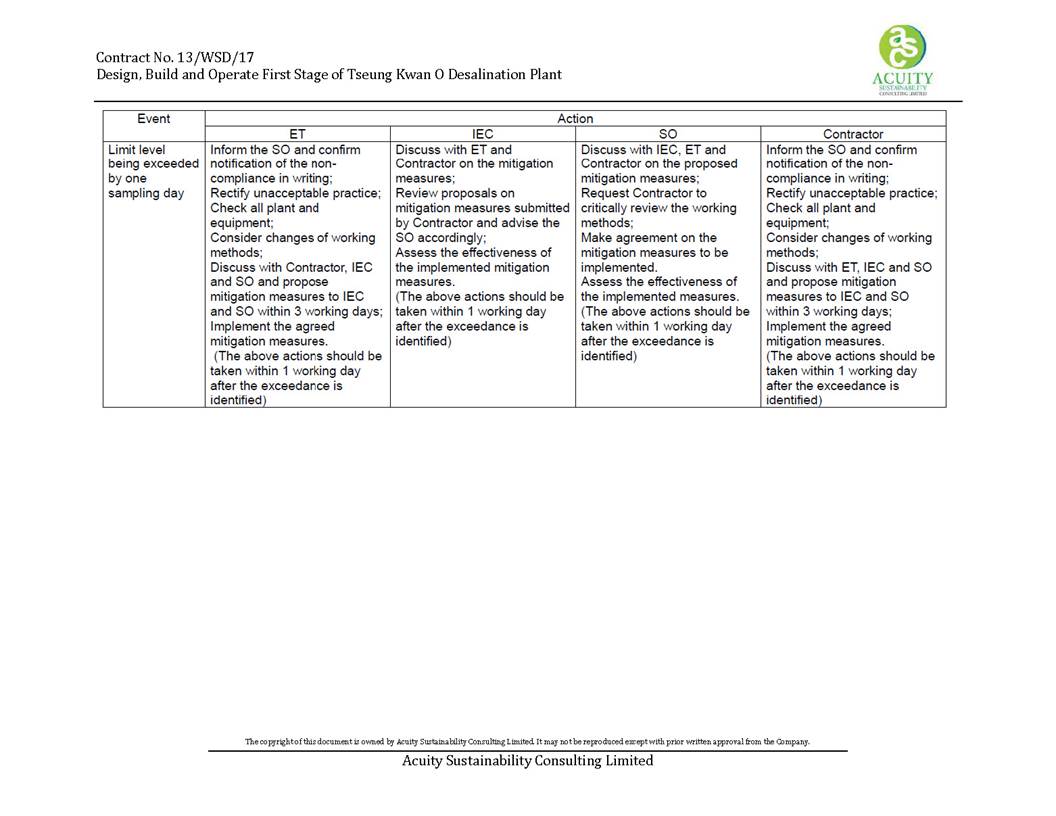
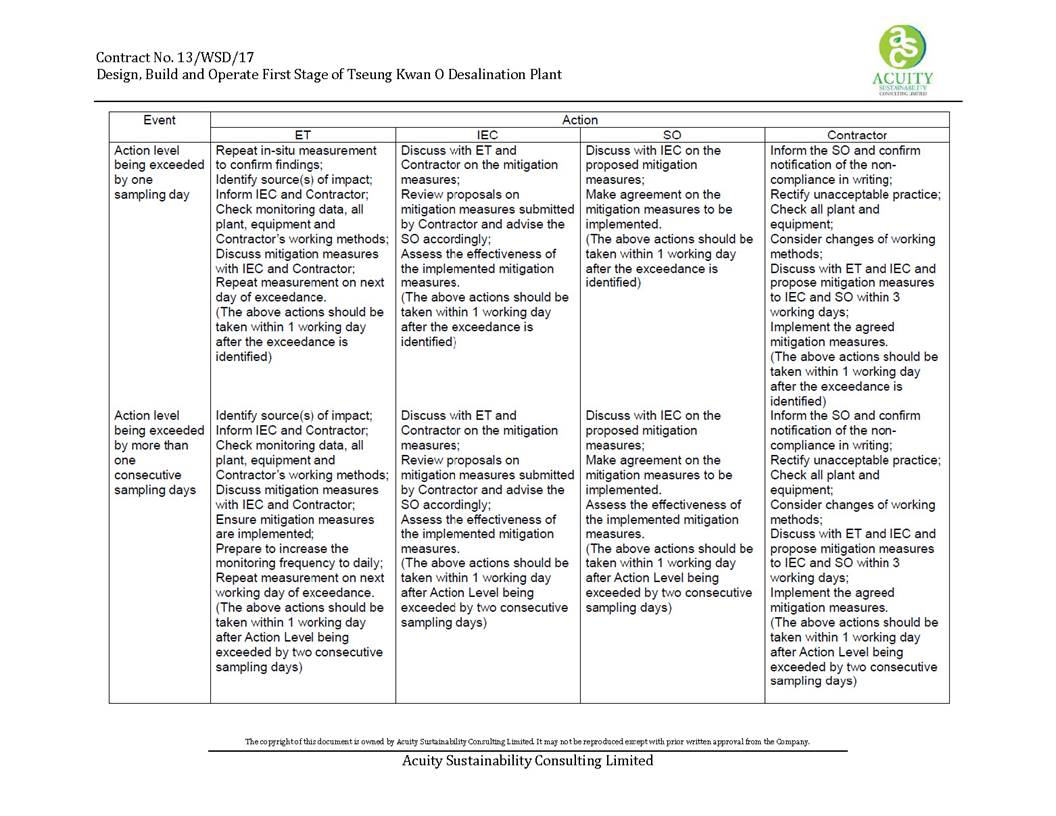
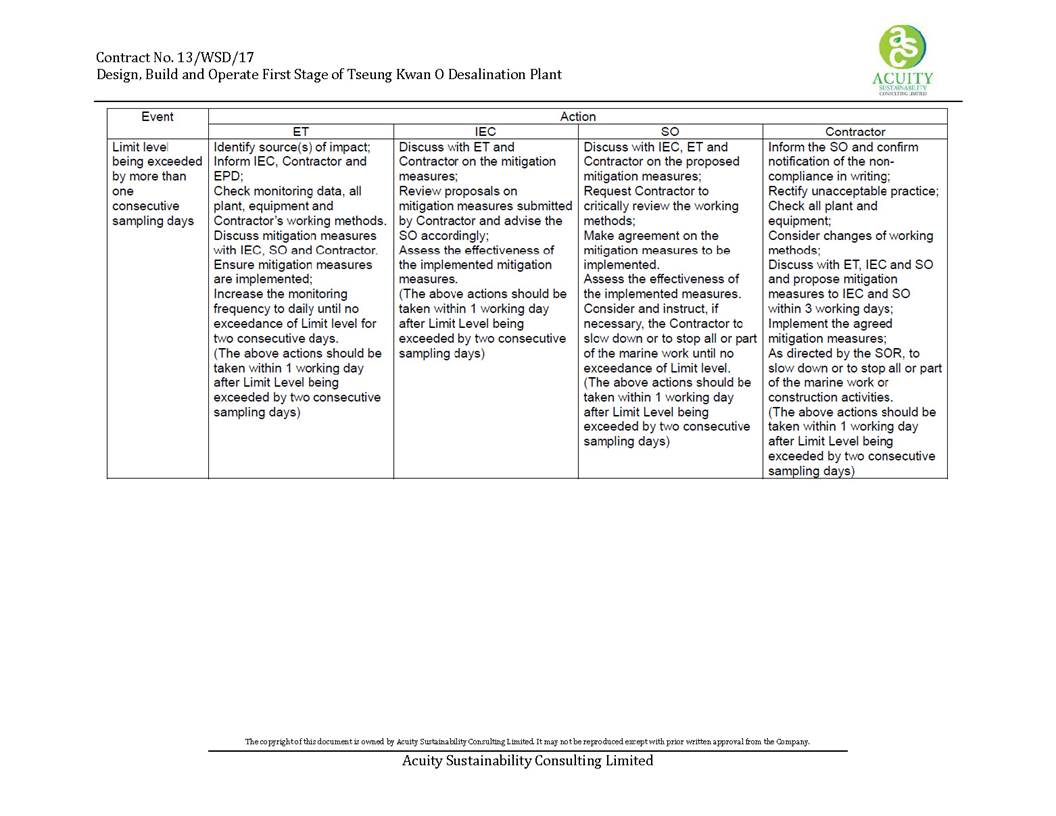
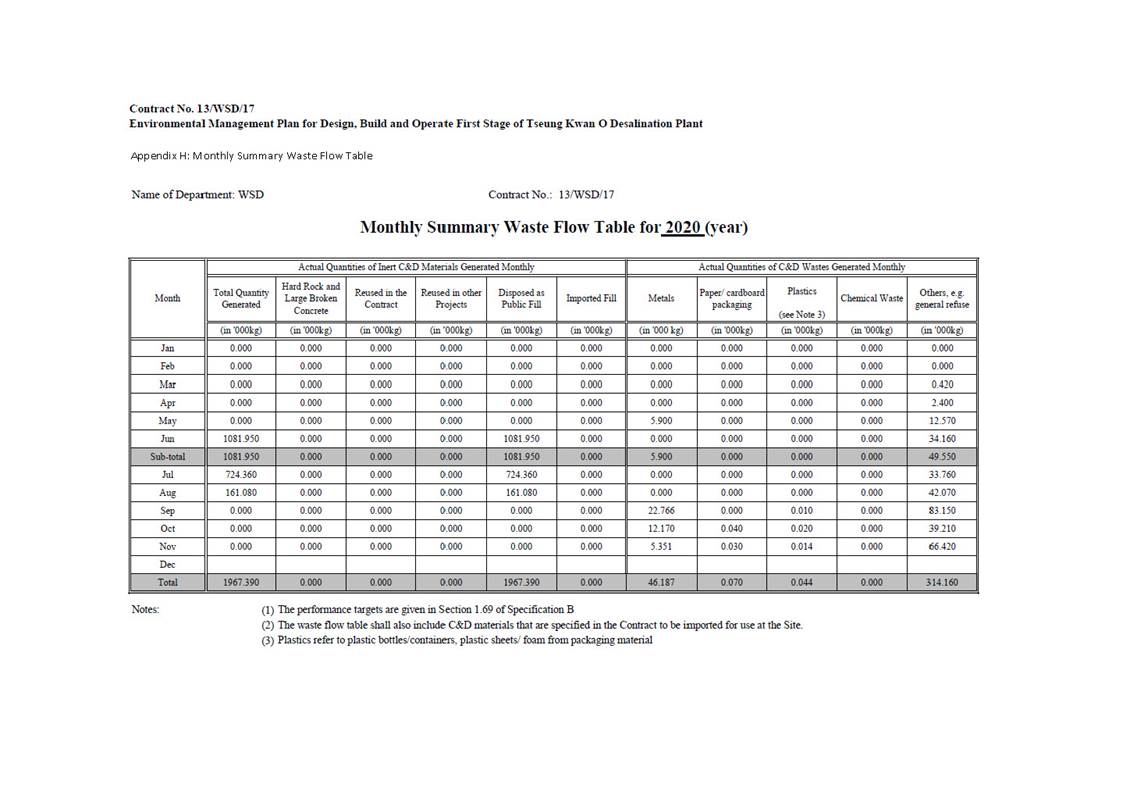
Site Inspection Proforma
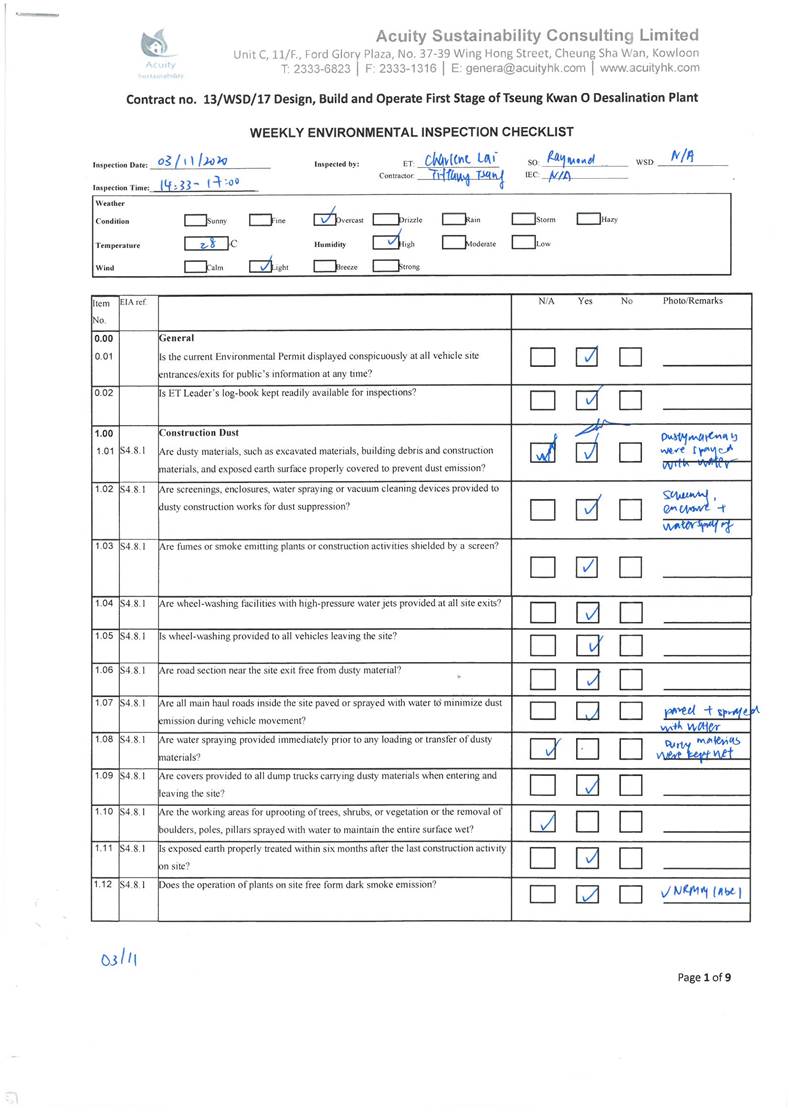
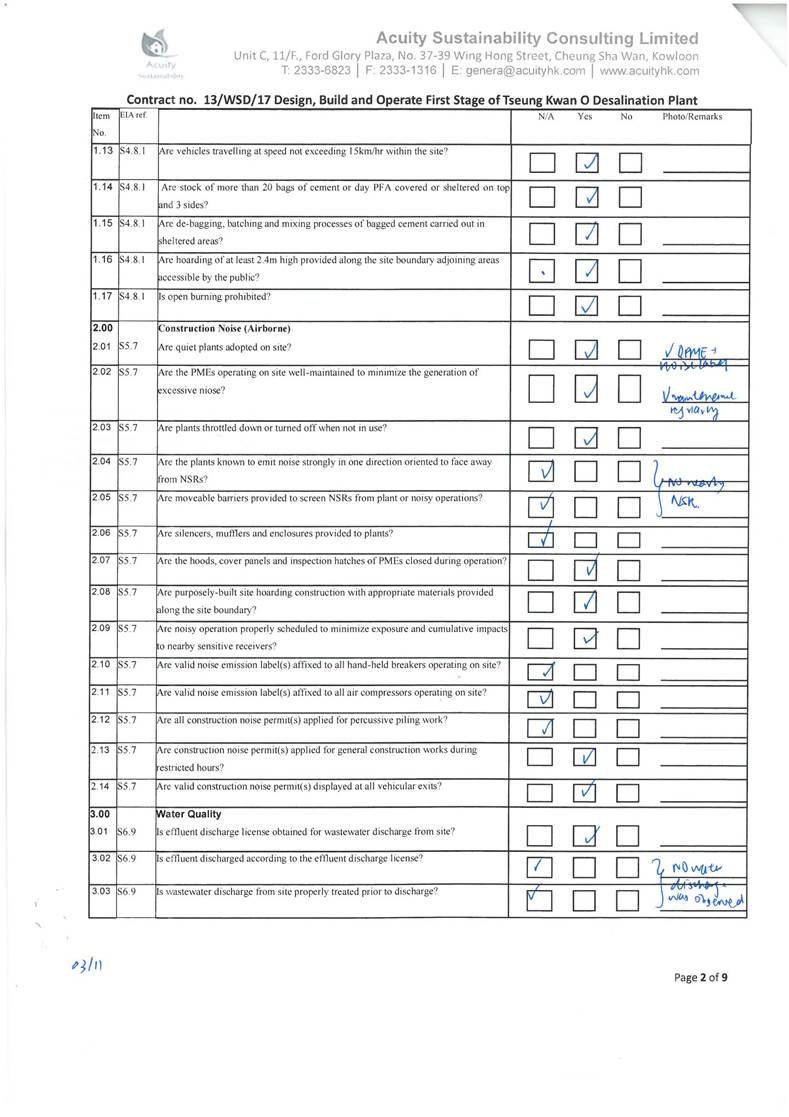
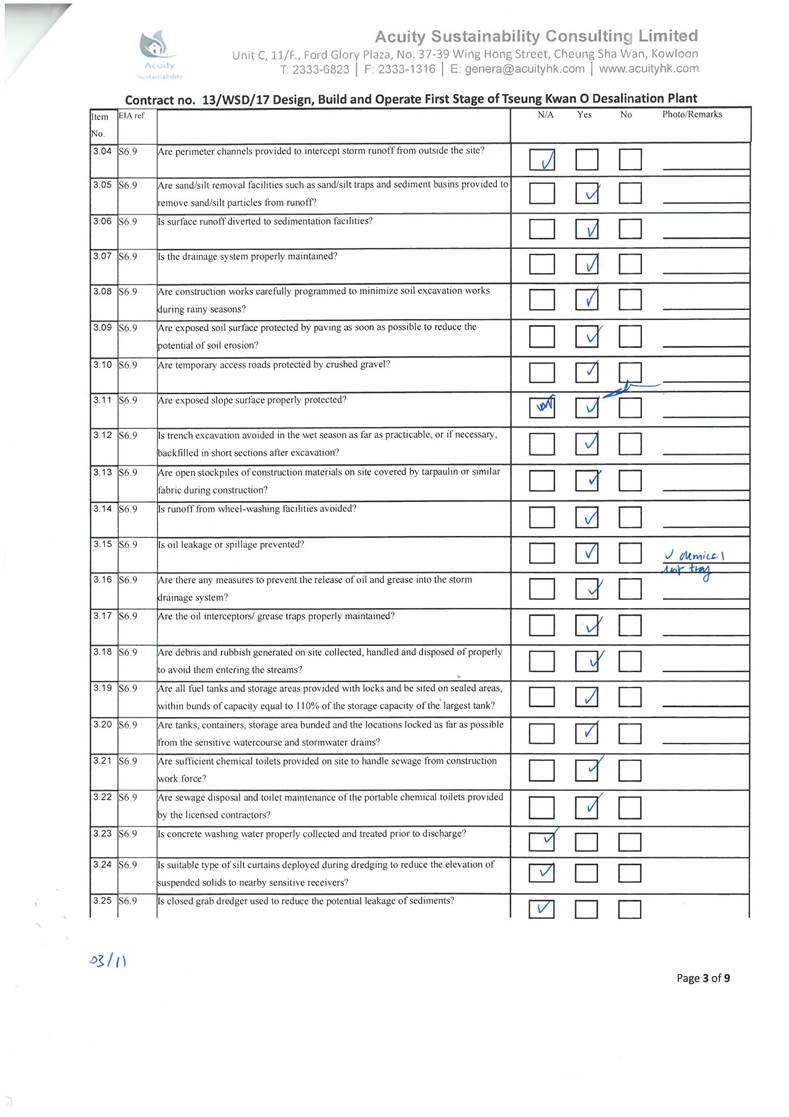
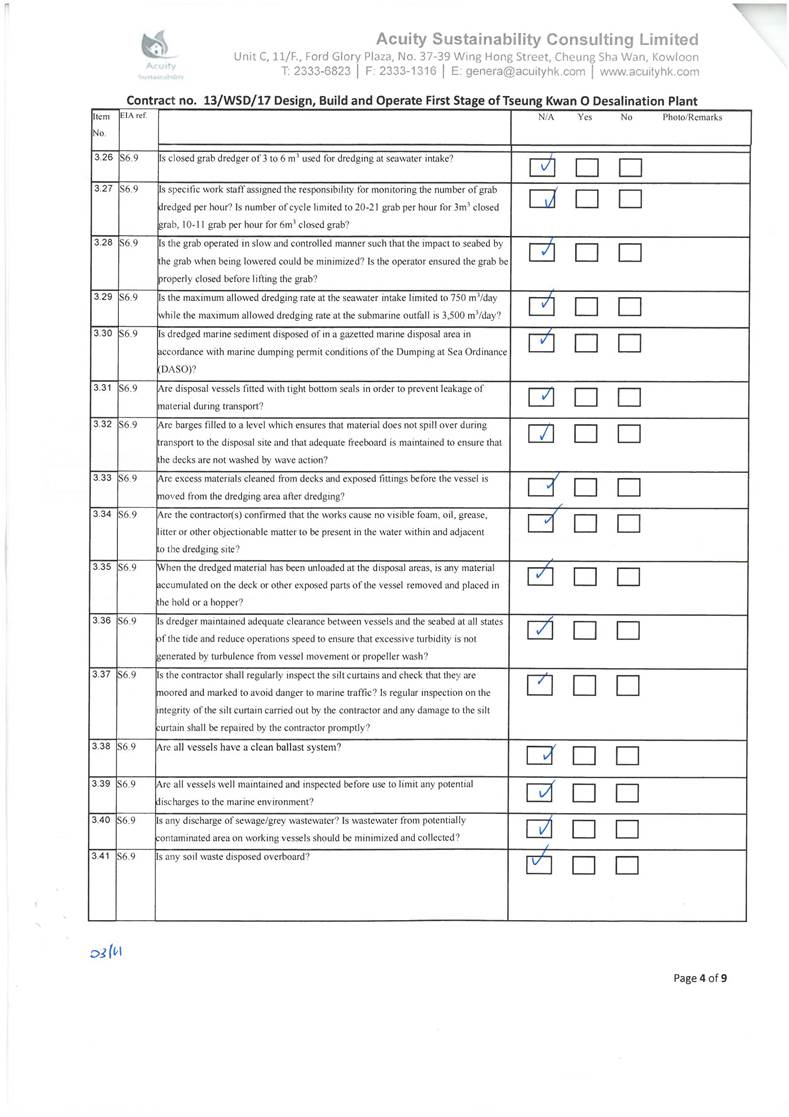
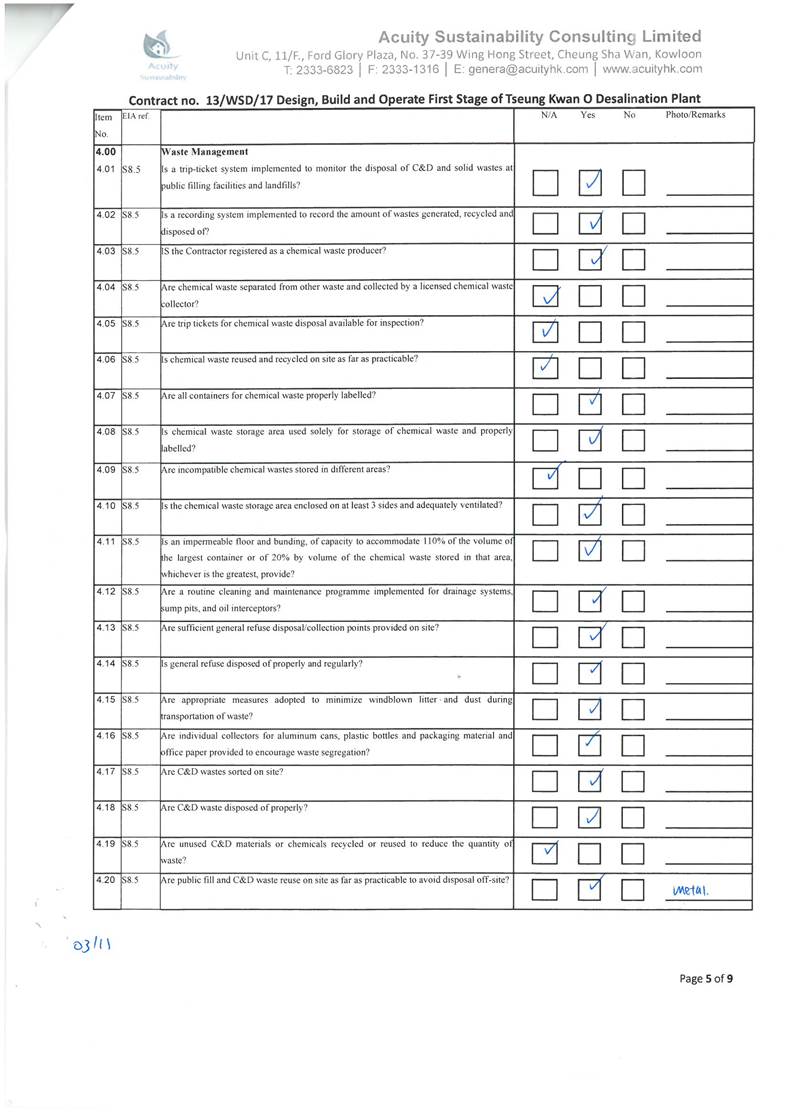
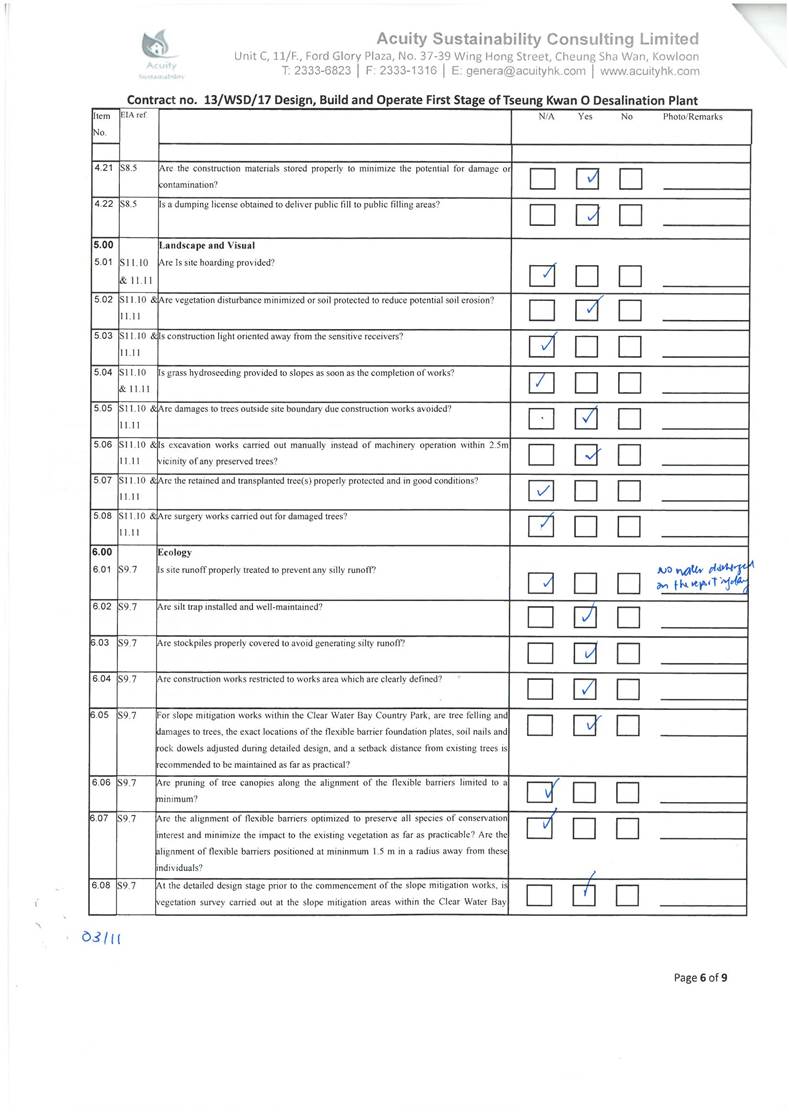
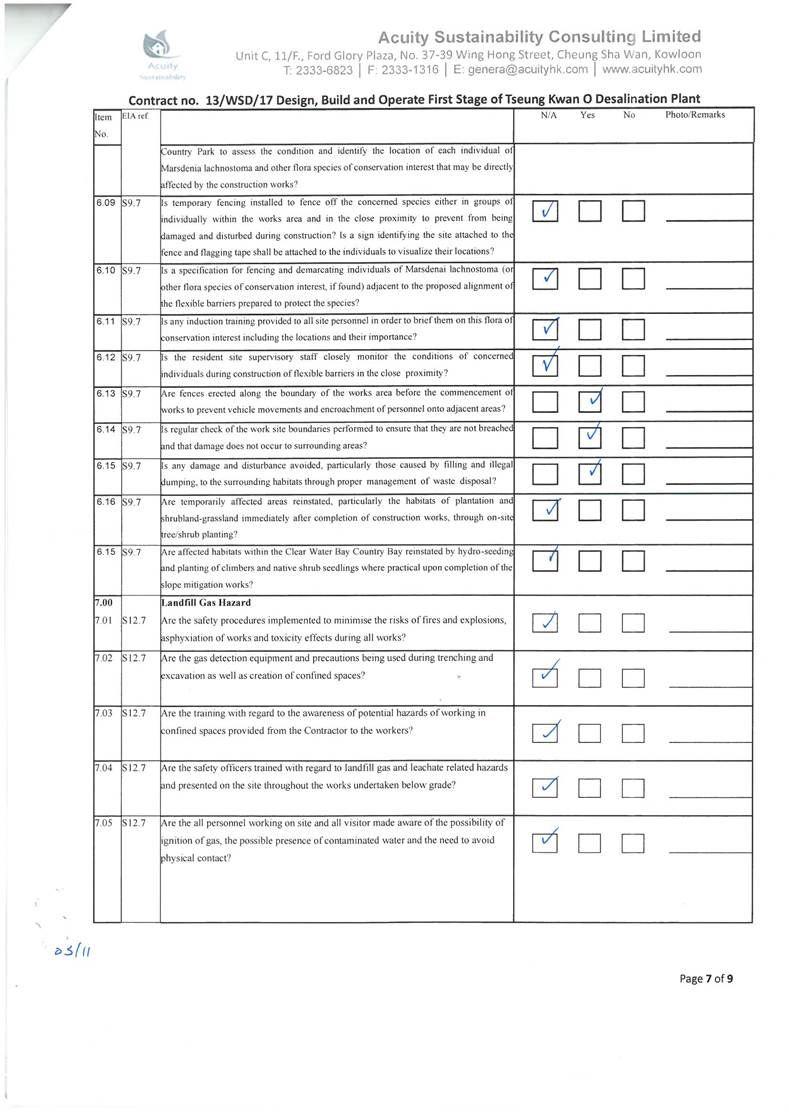
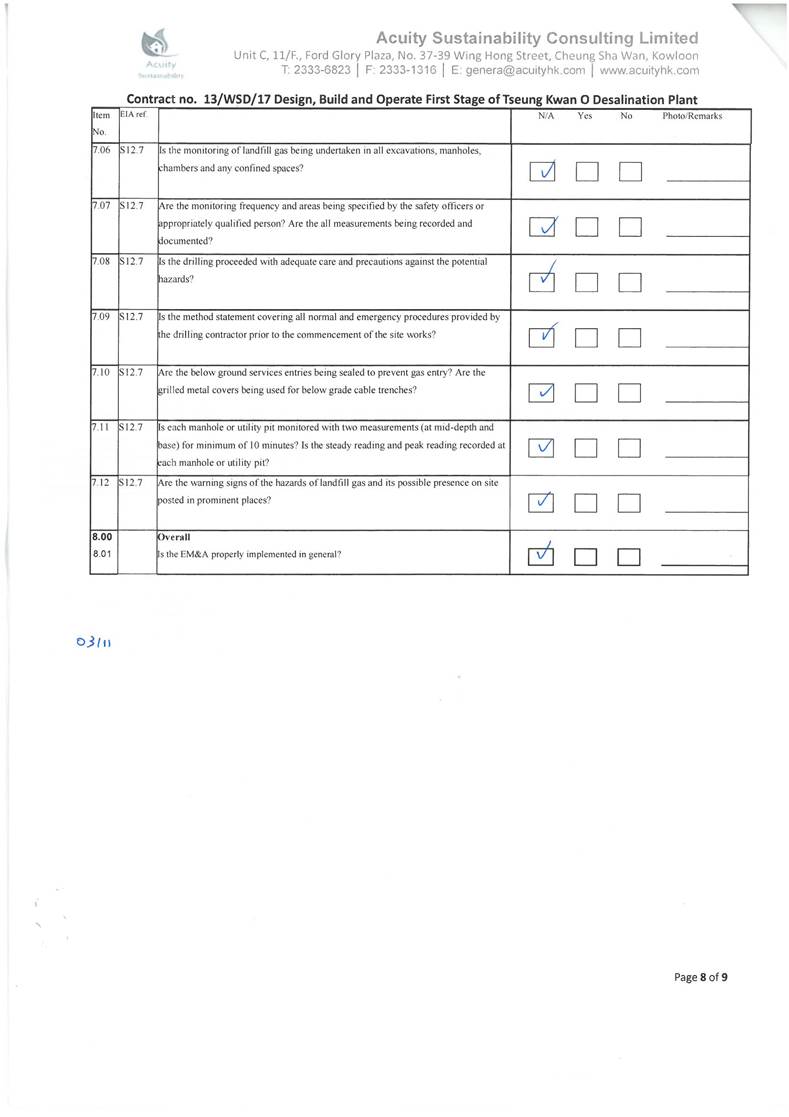
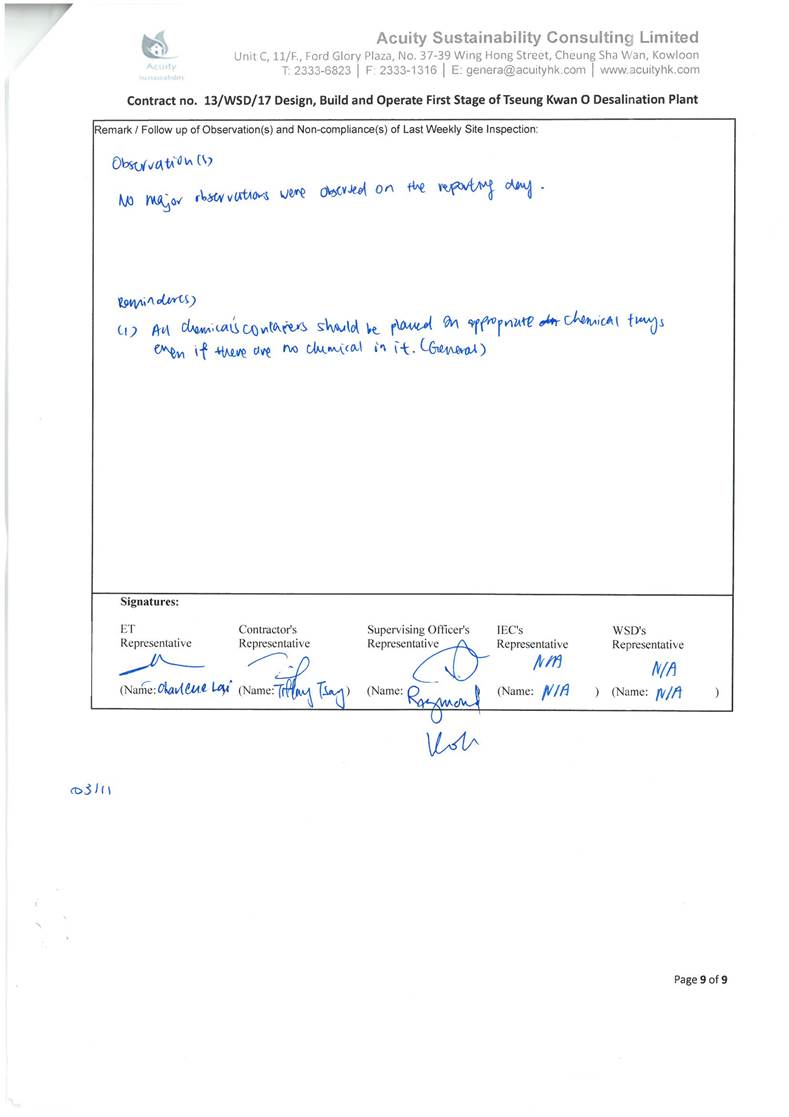
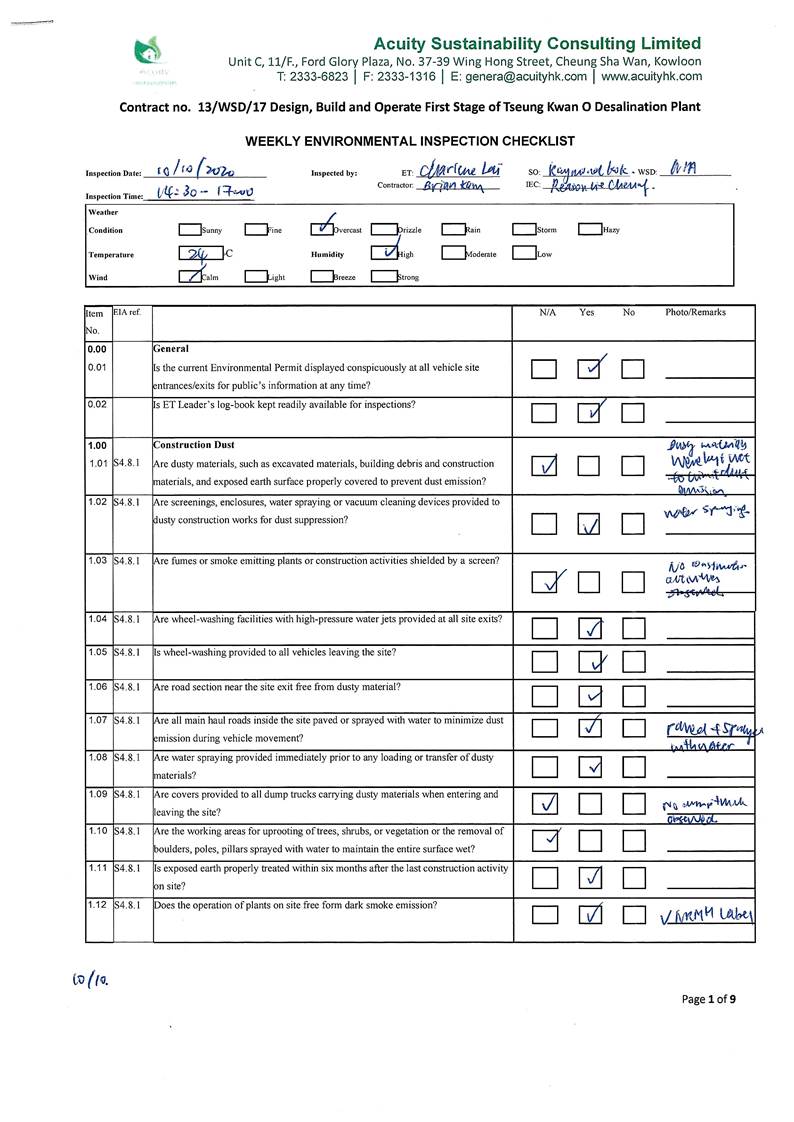
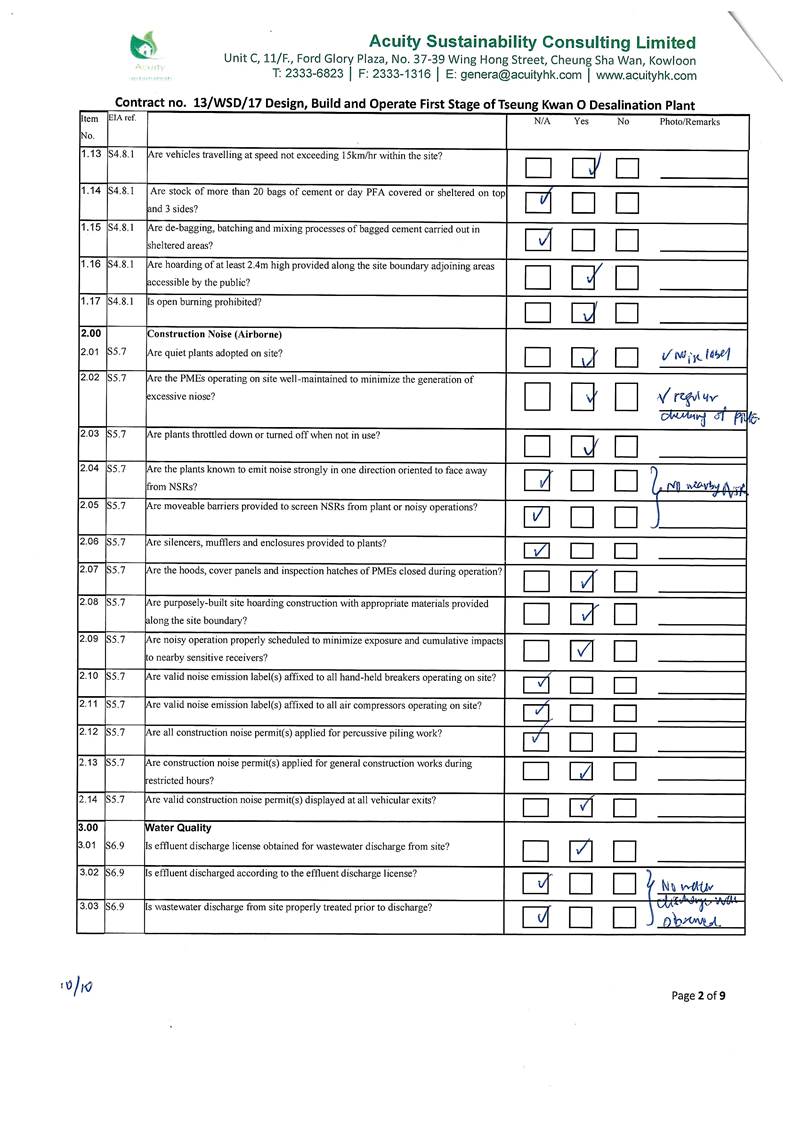
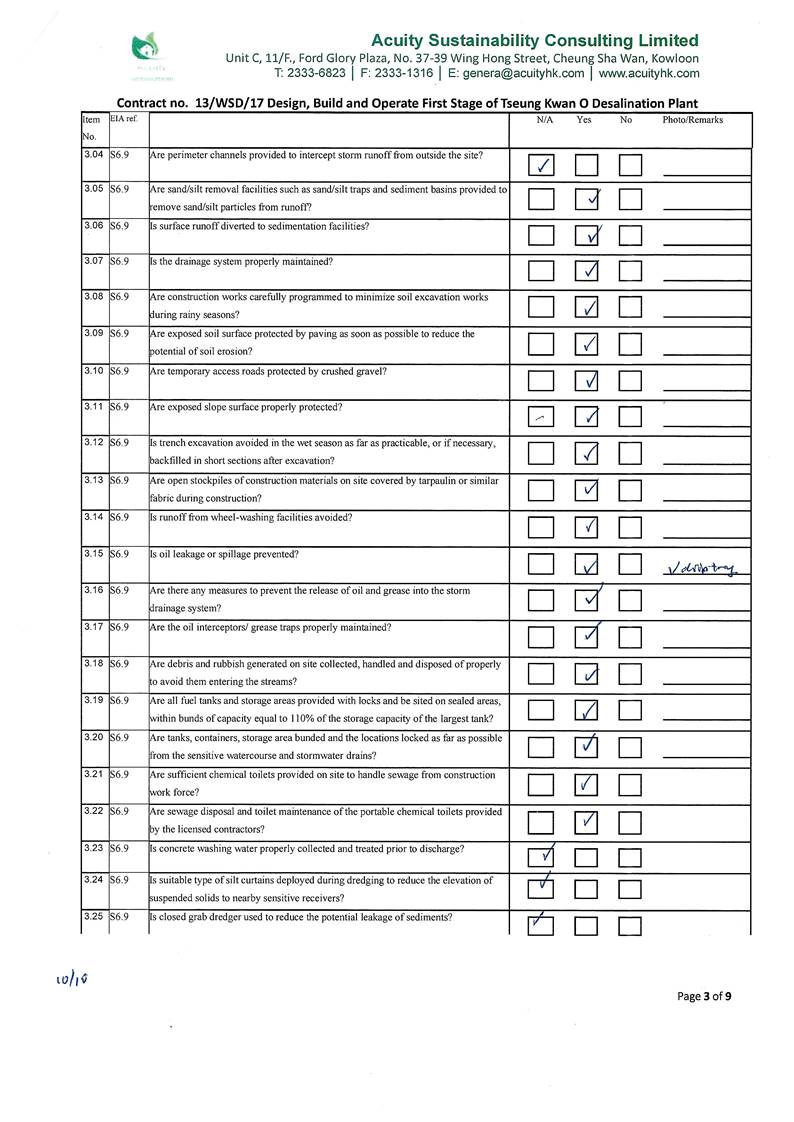
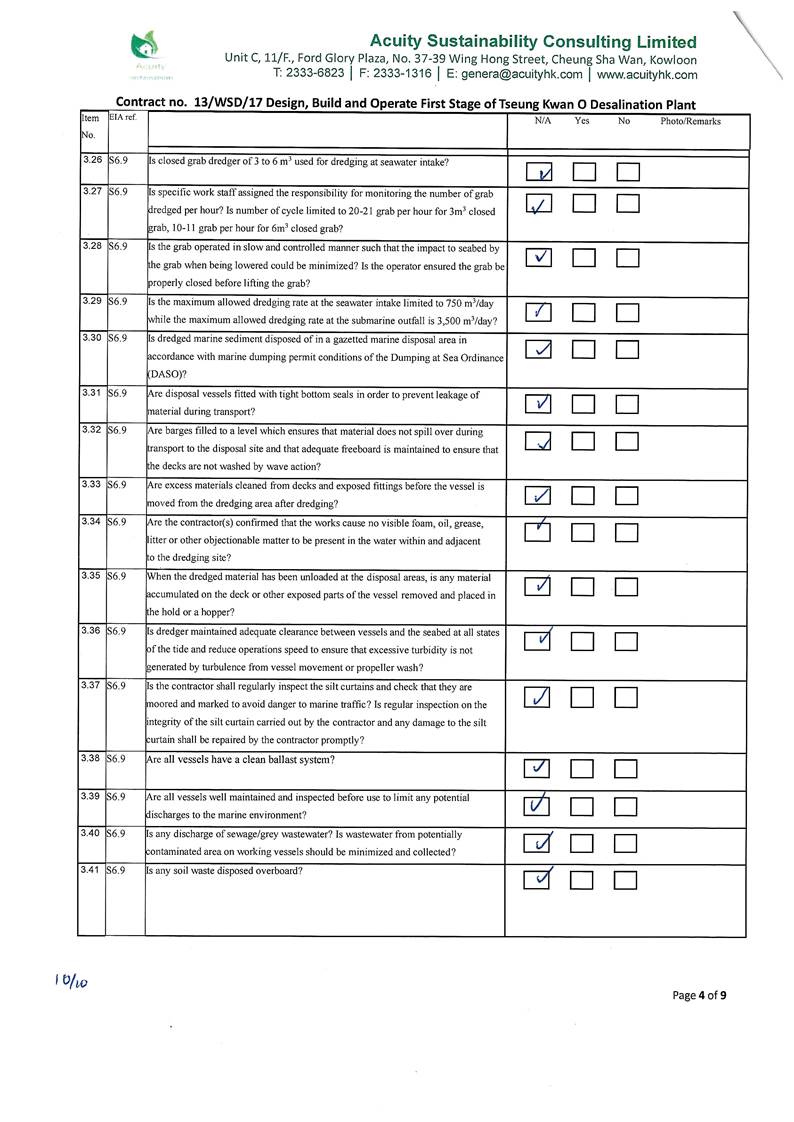
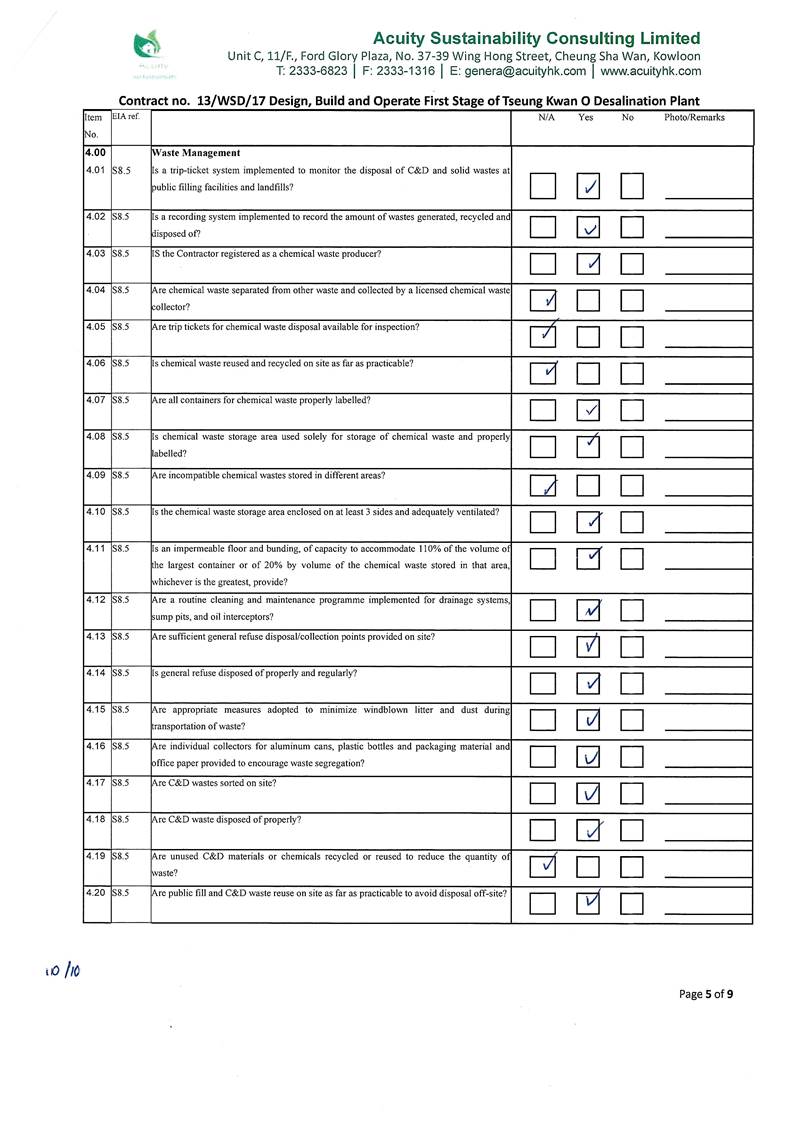
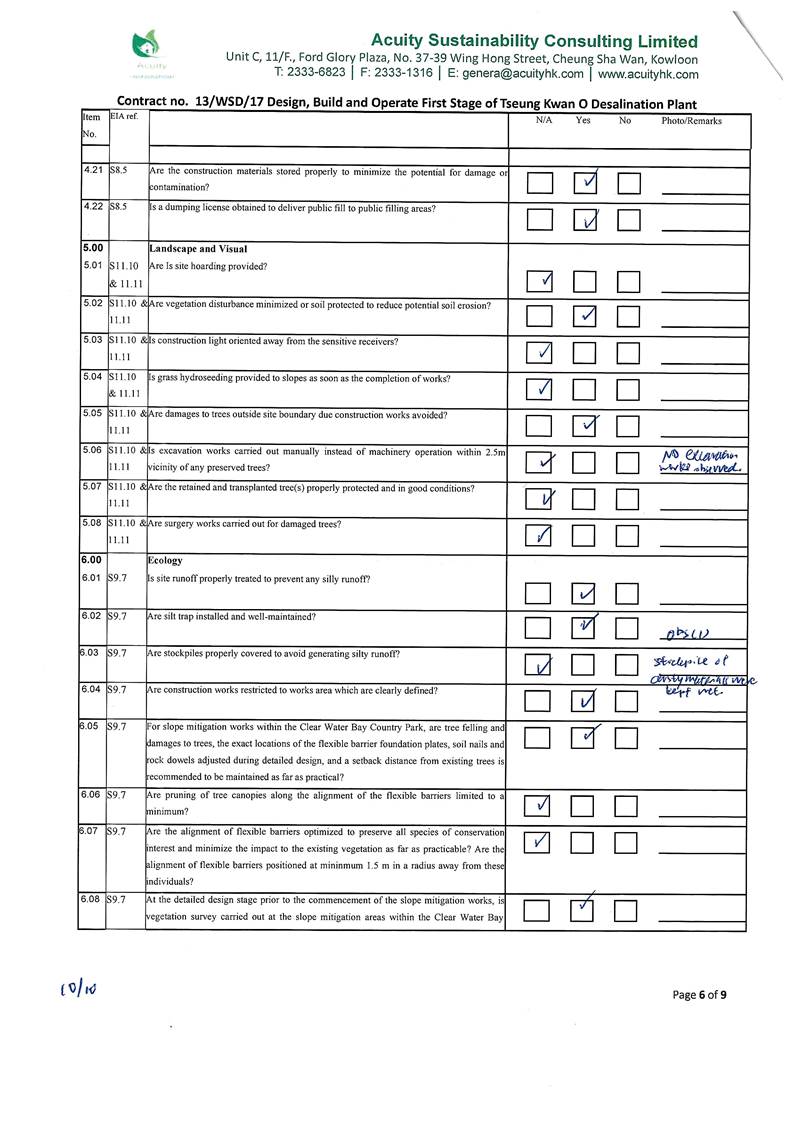
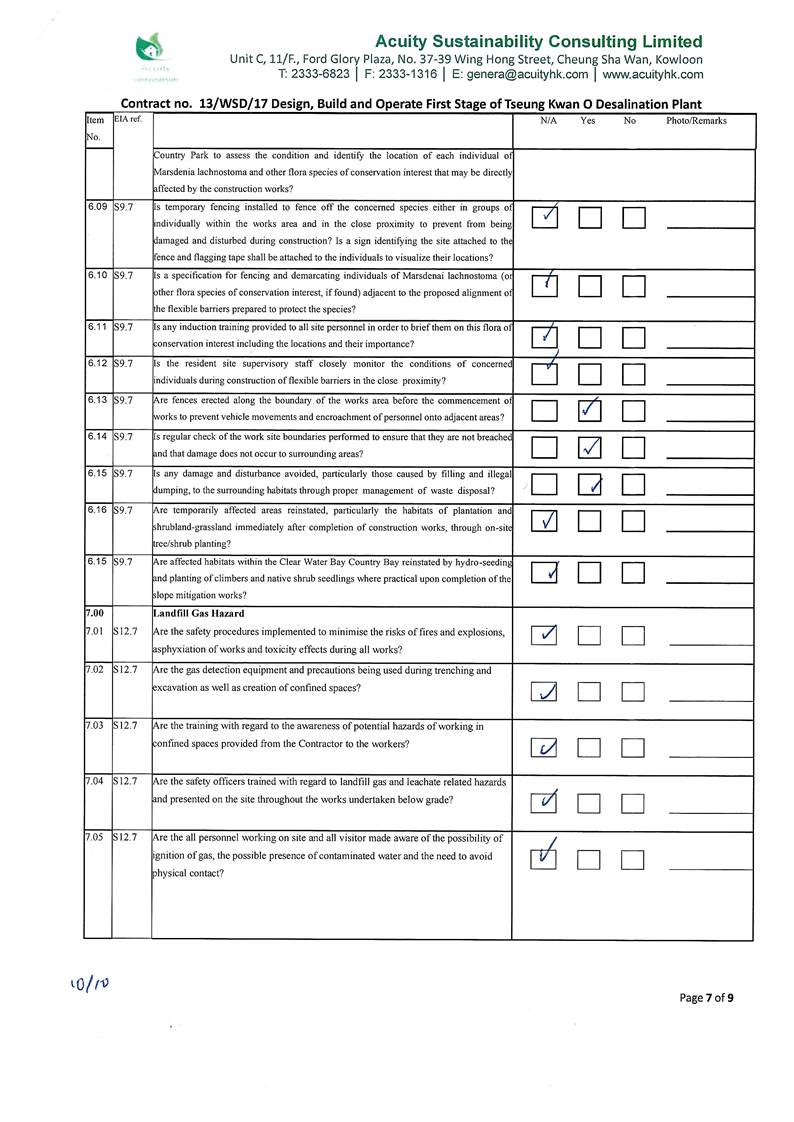
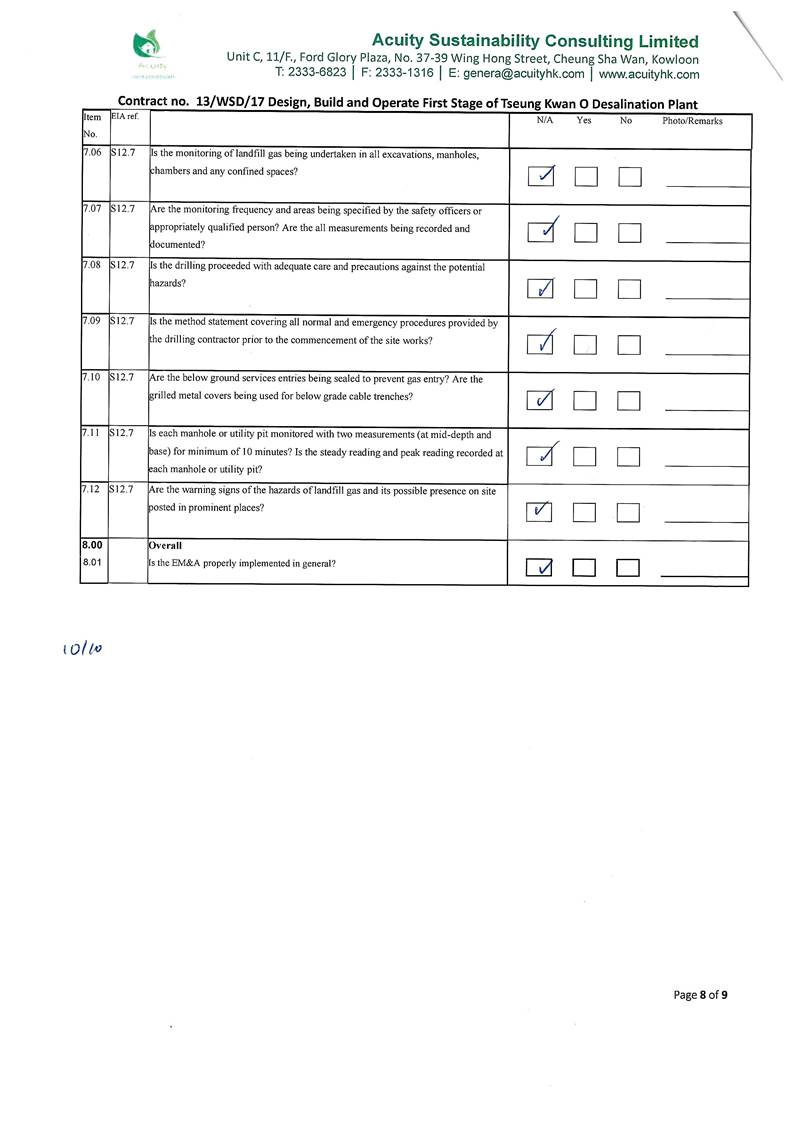
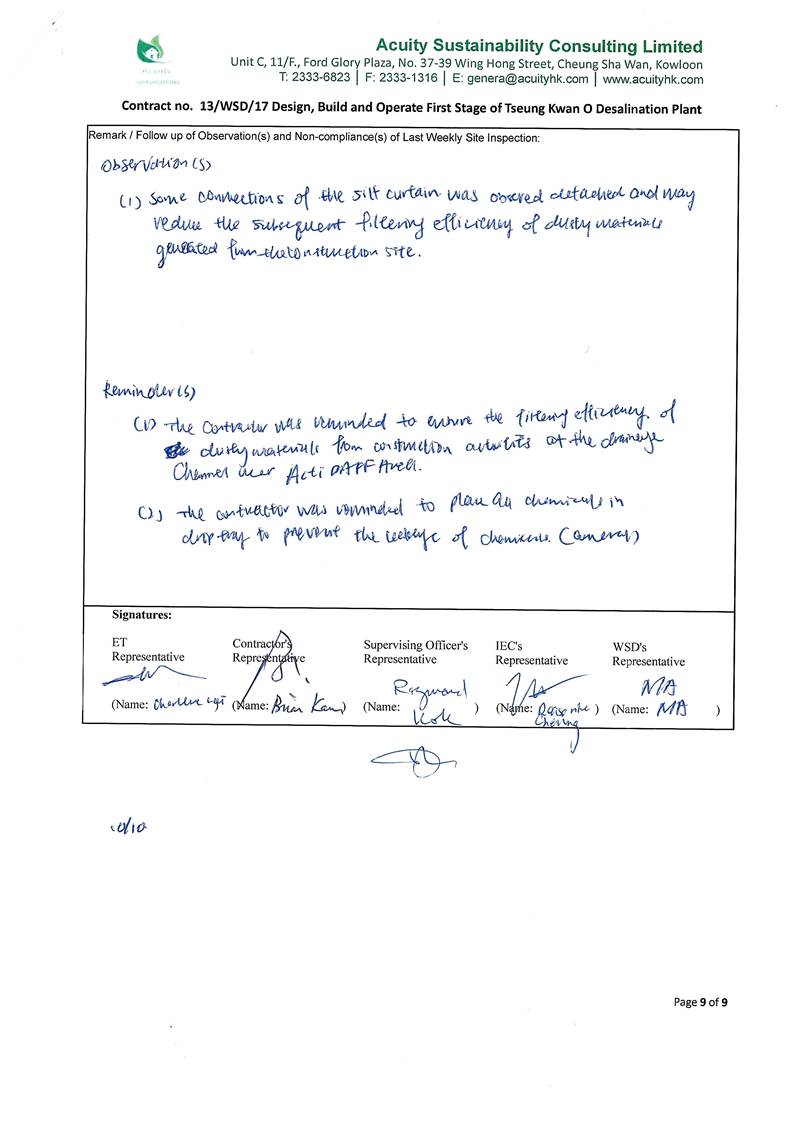
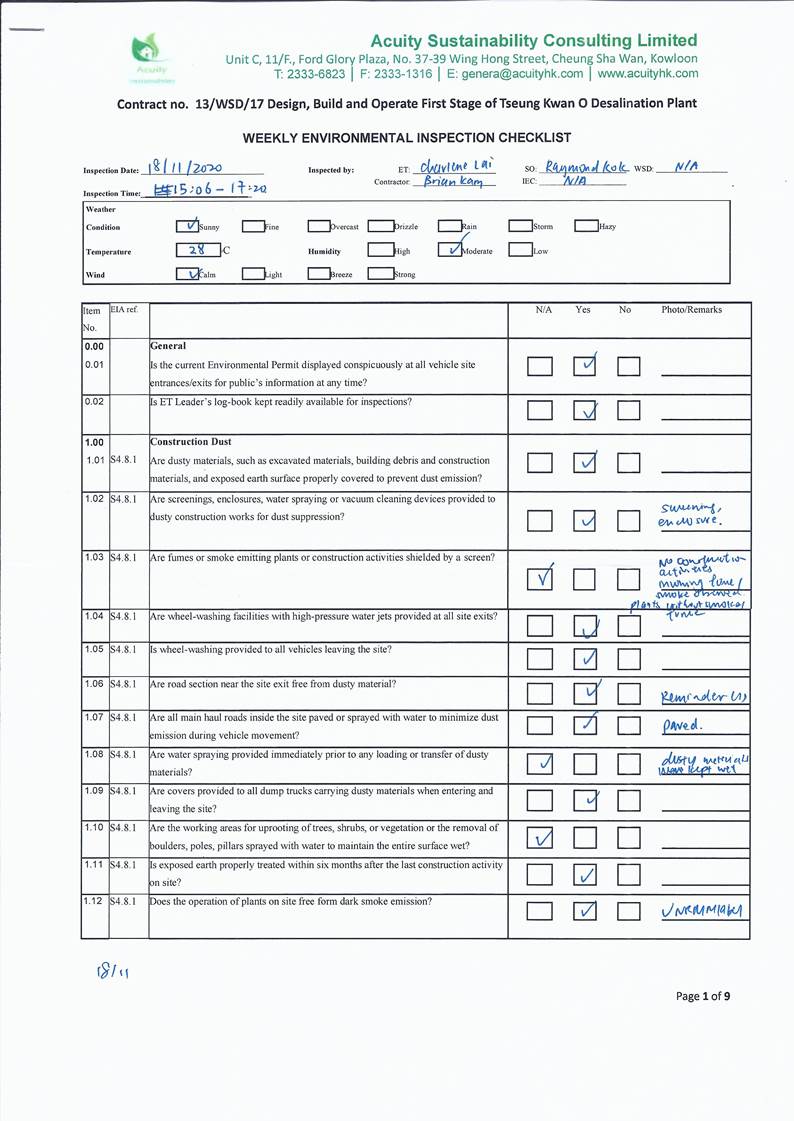
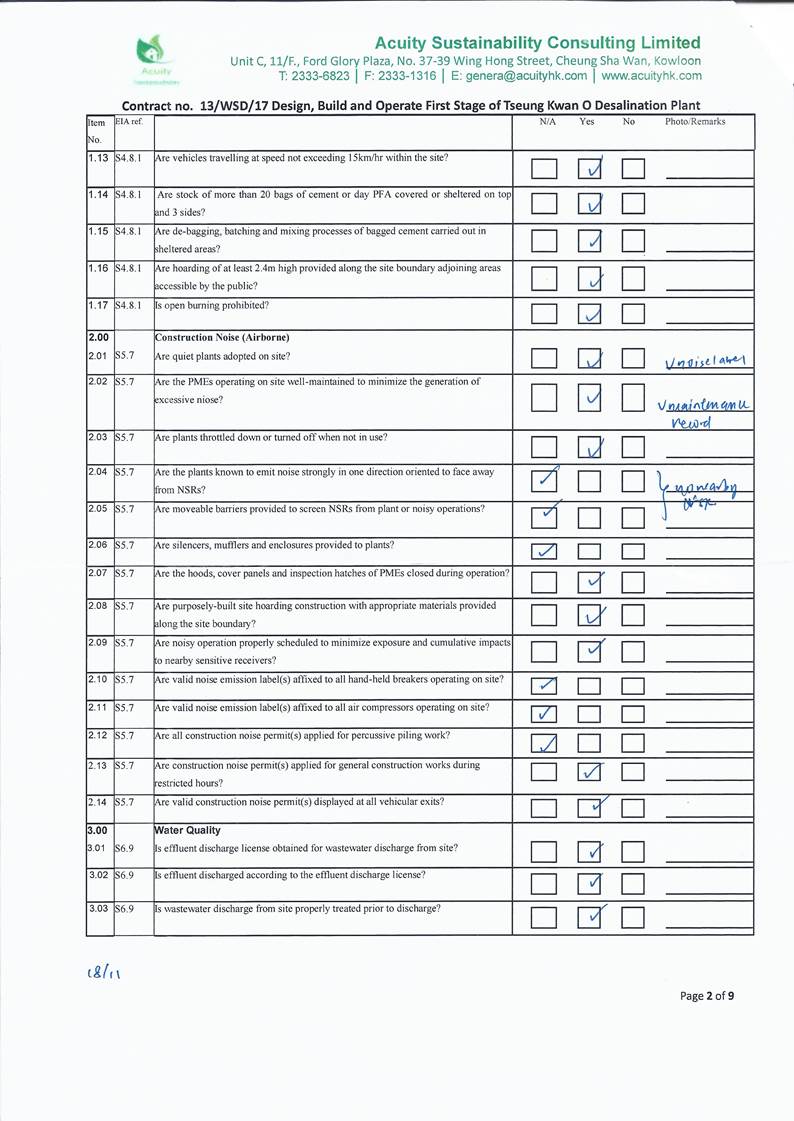
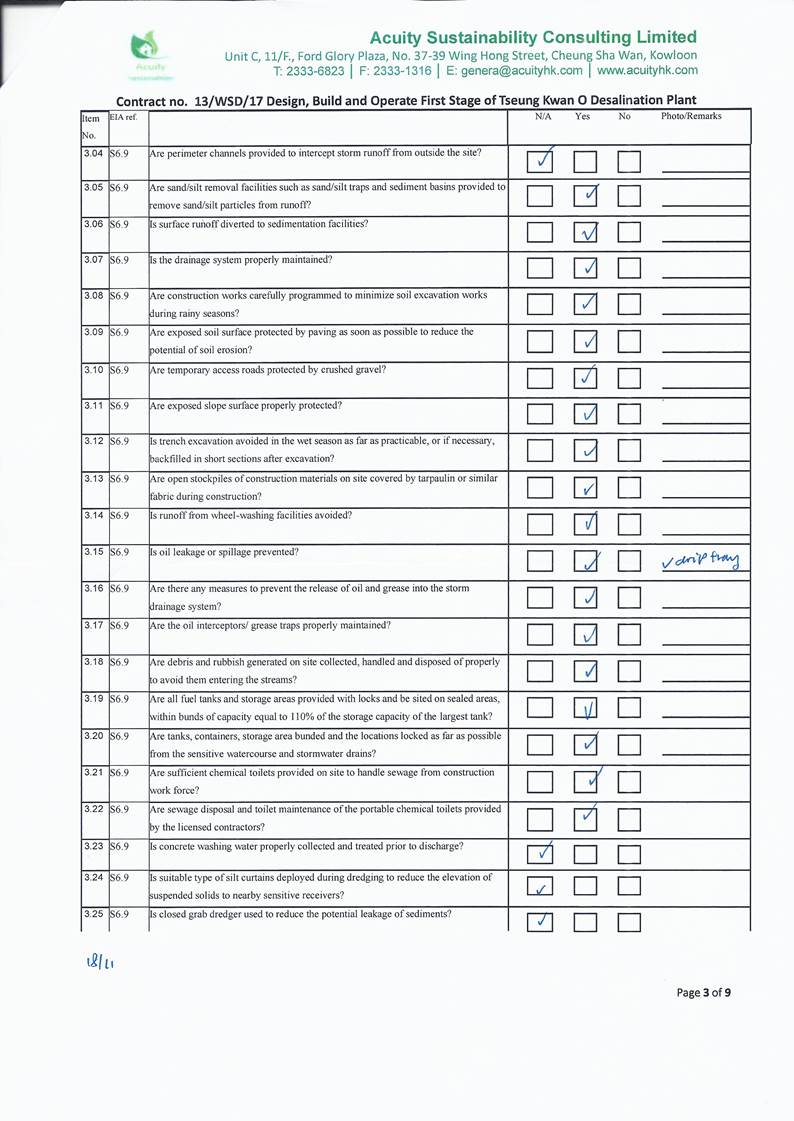
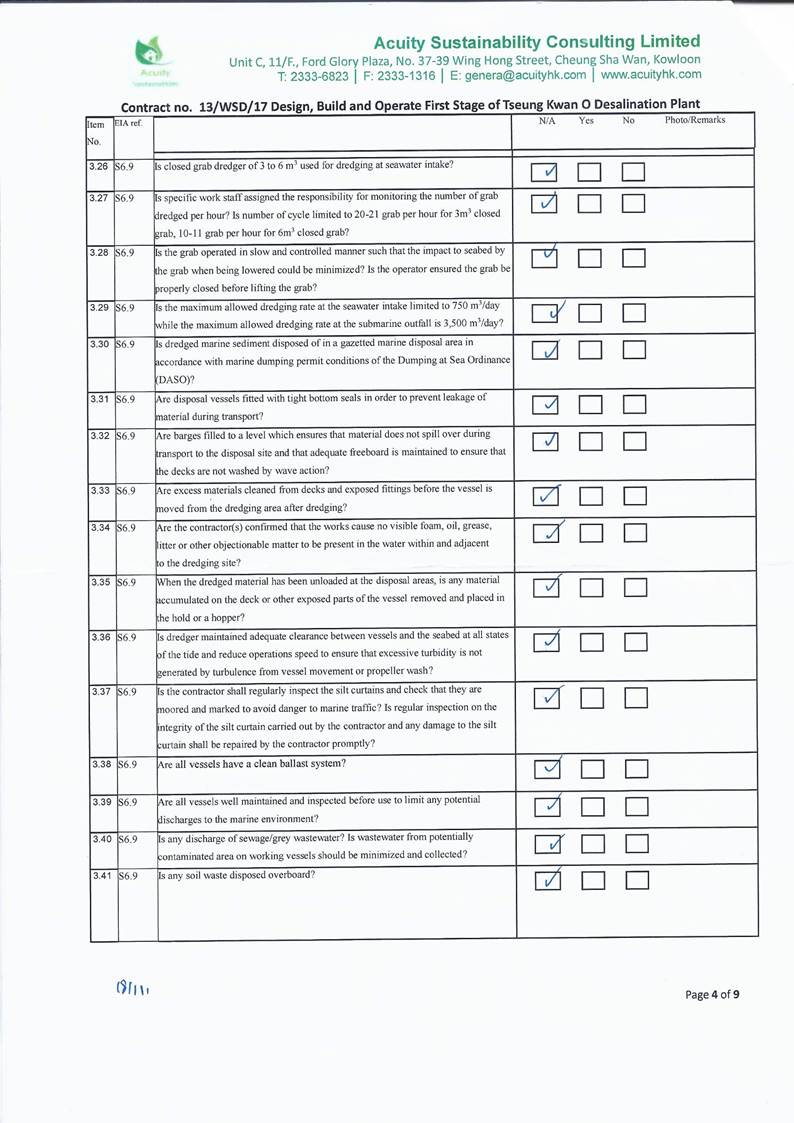
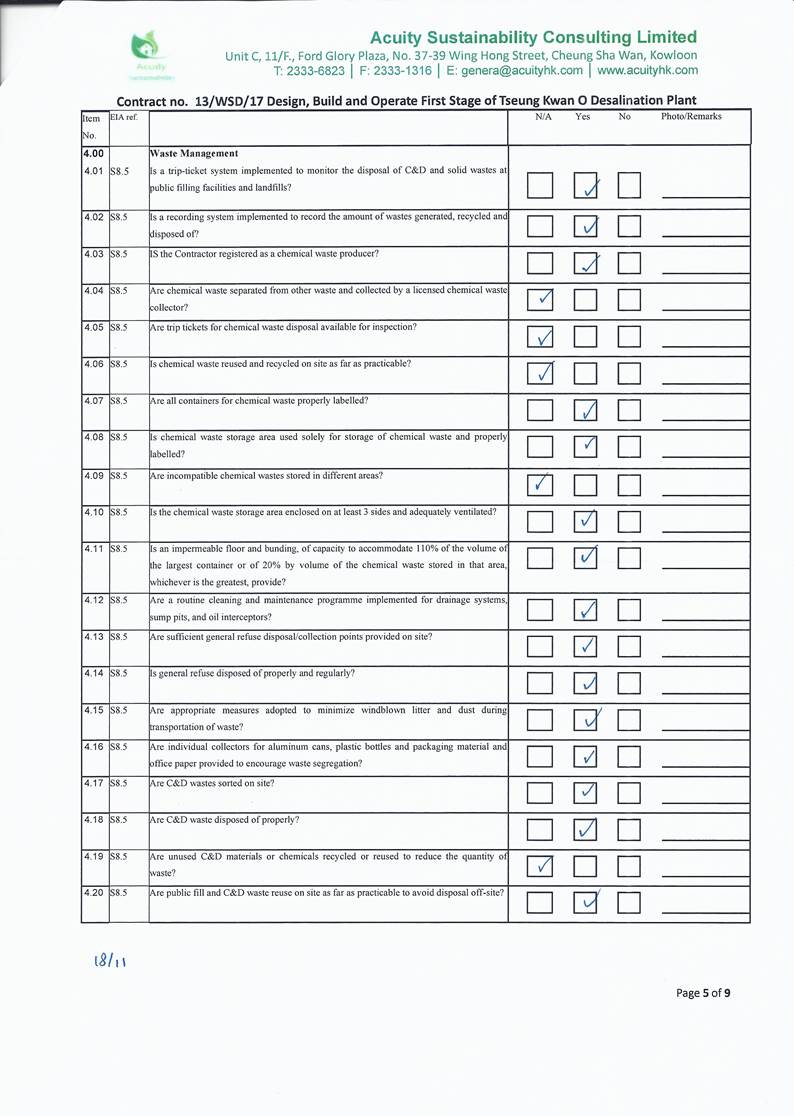
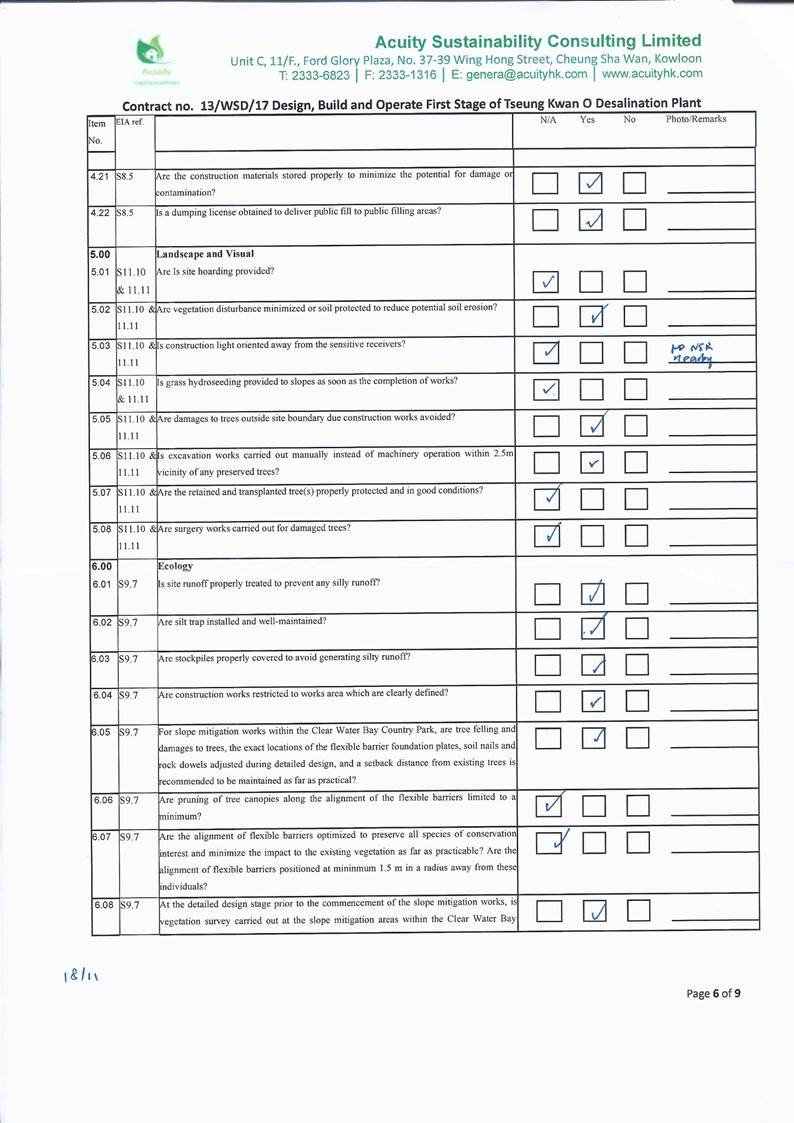
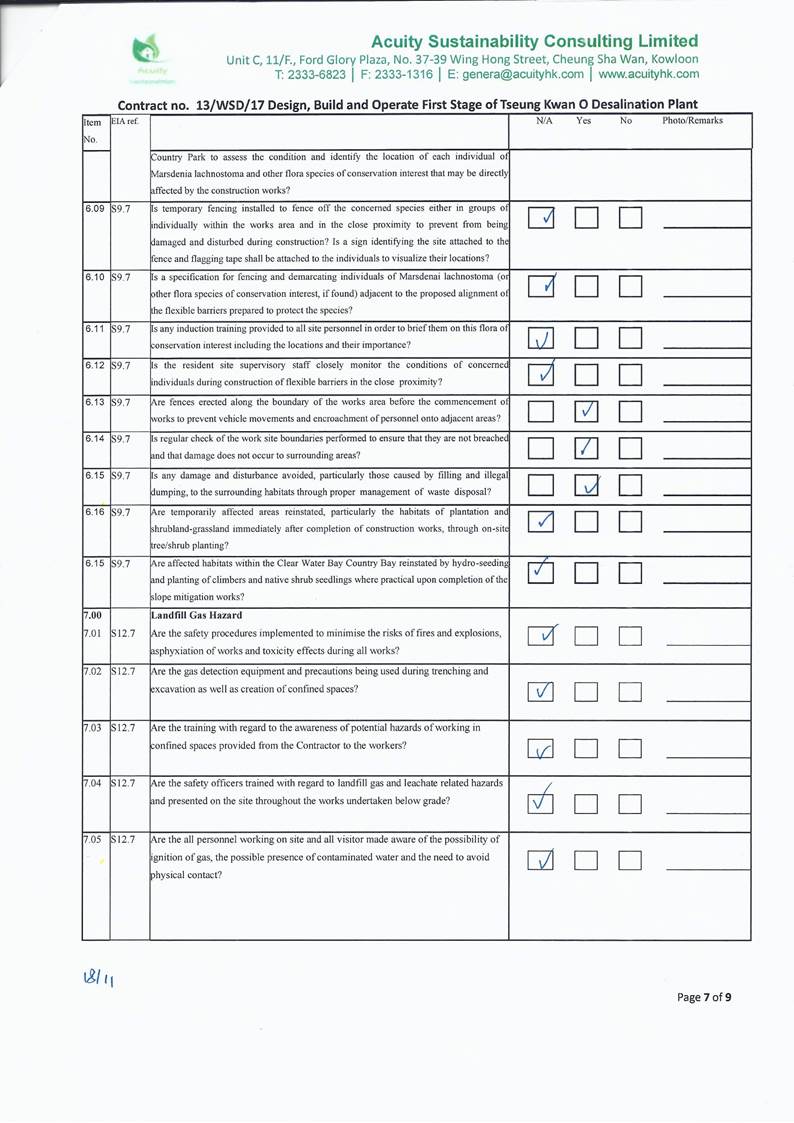
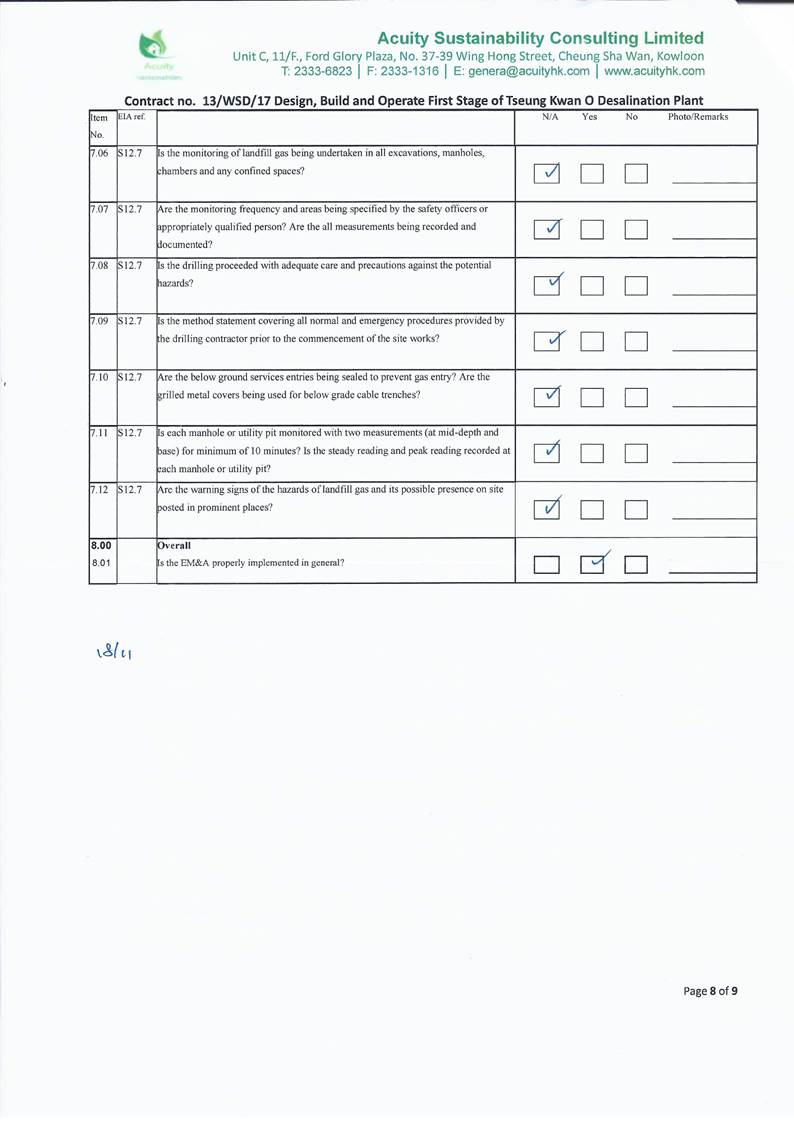
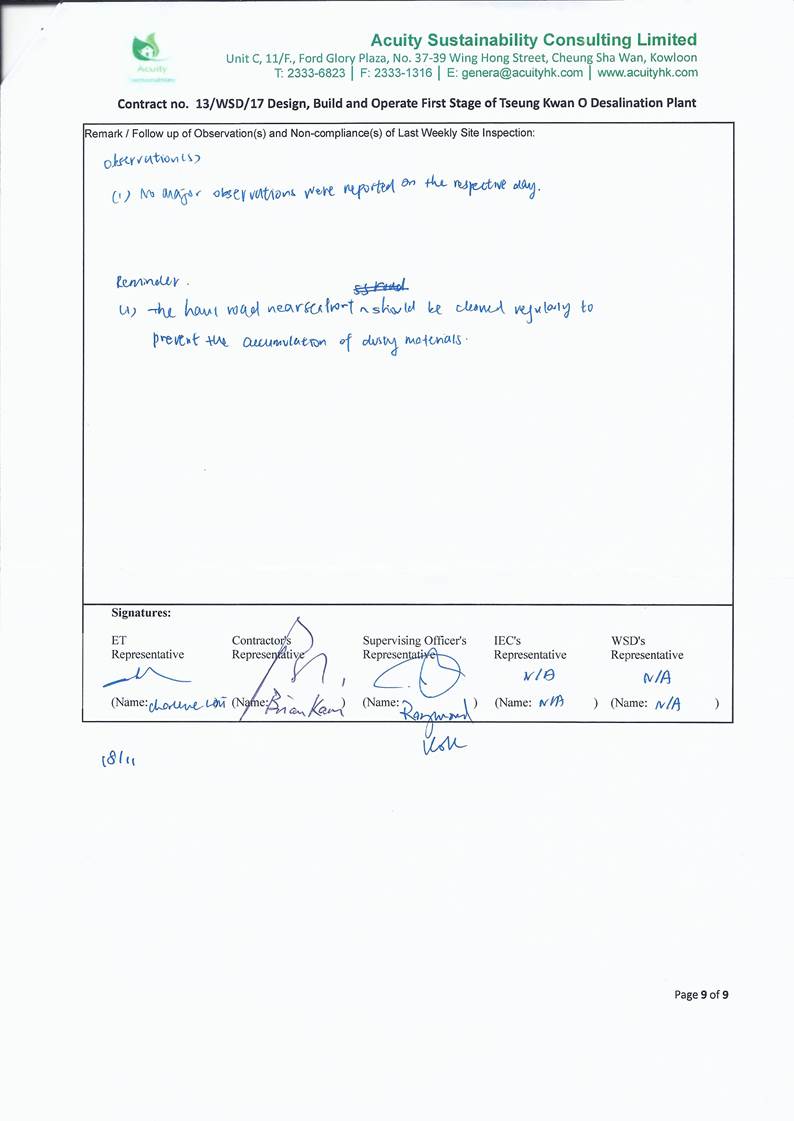
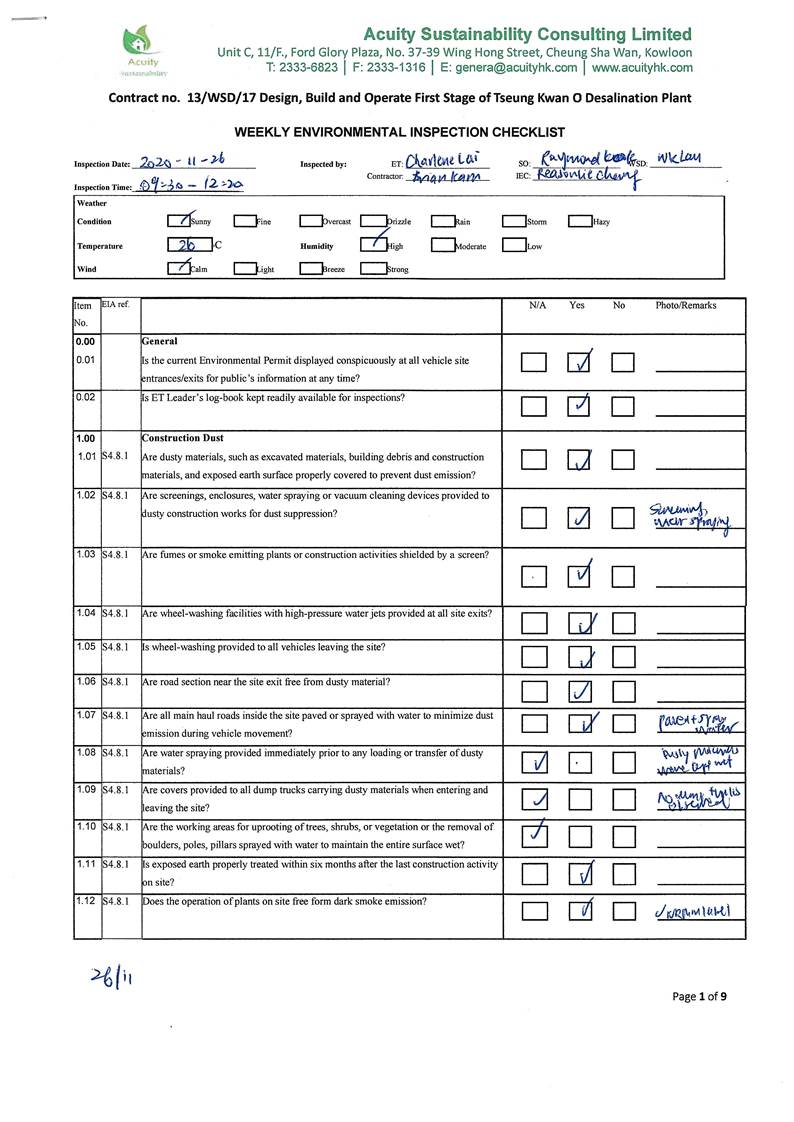
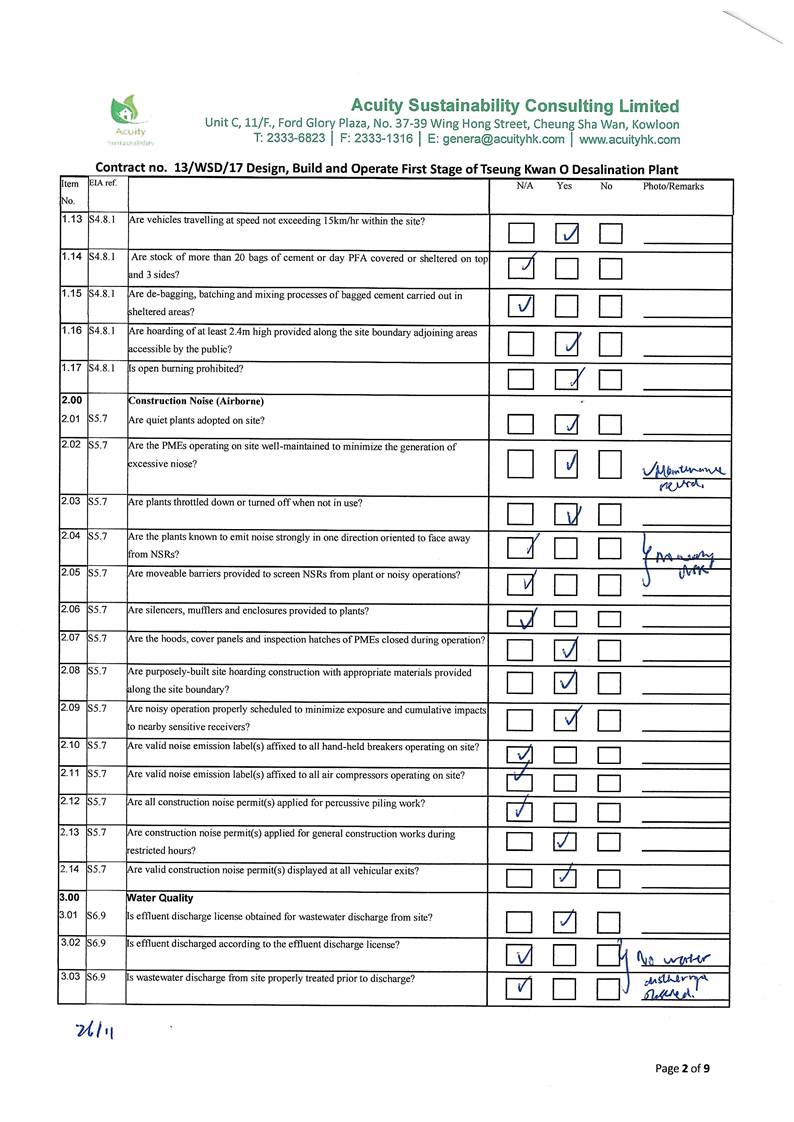
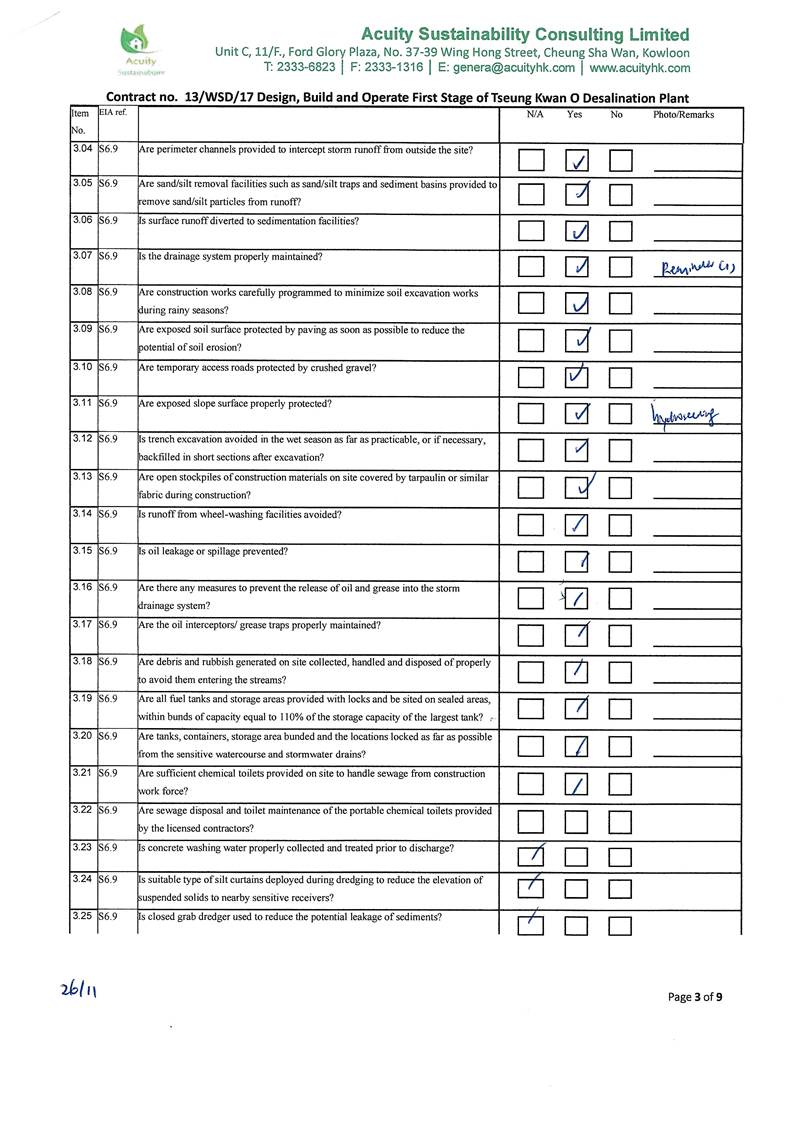
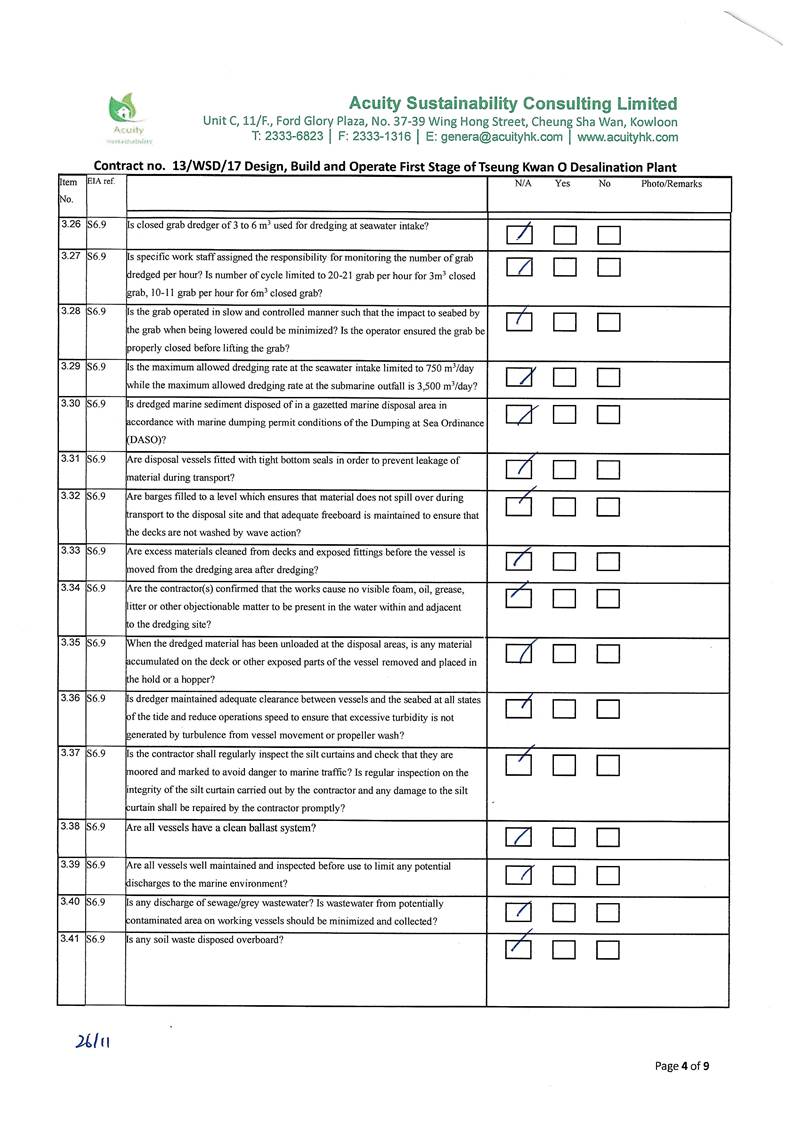
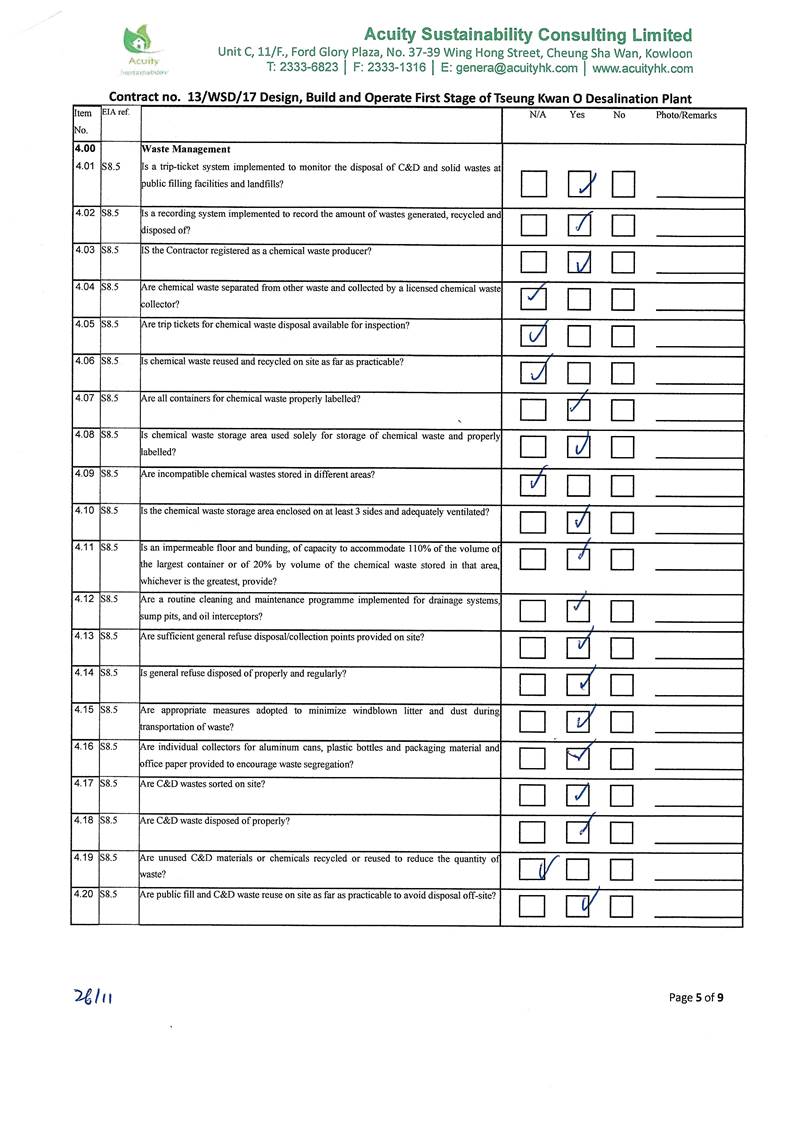
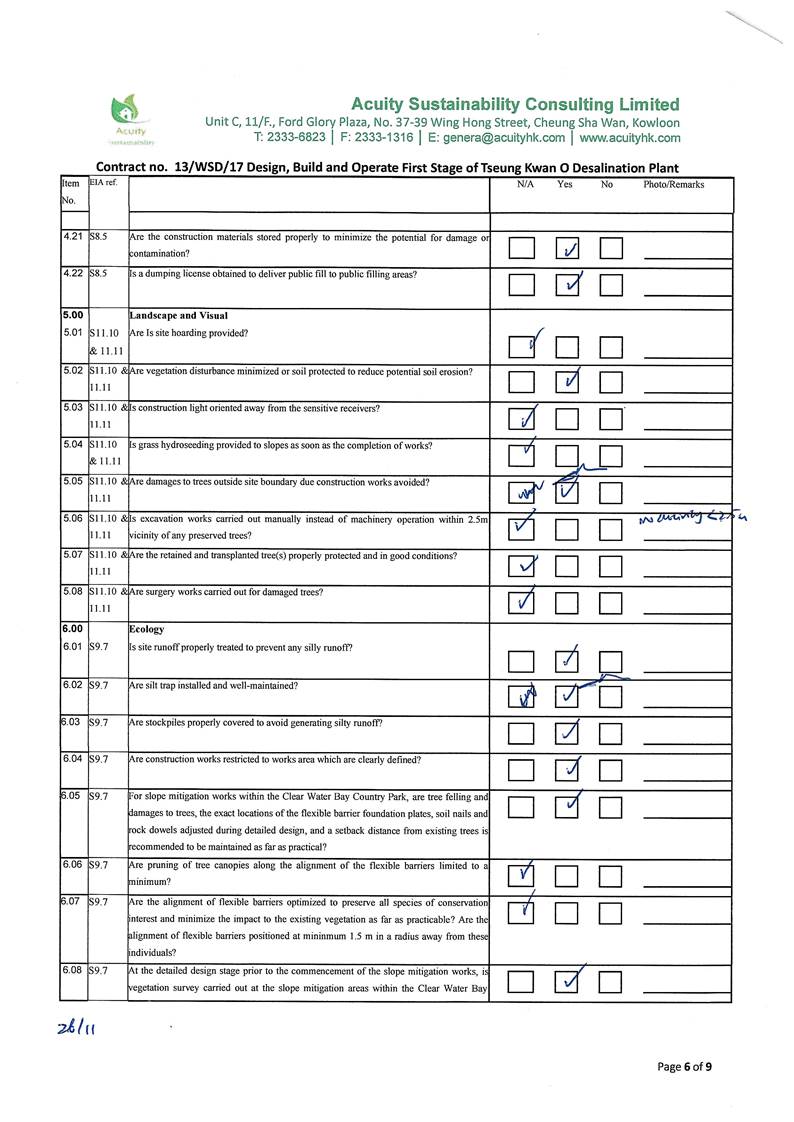
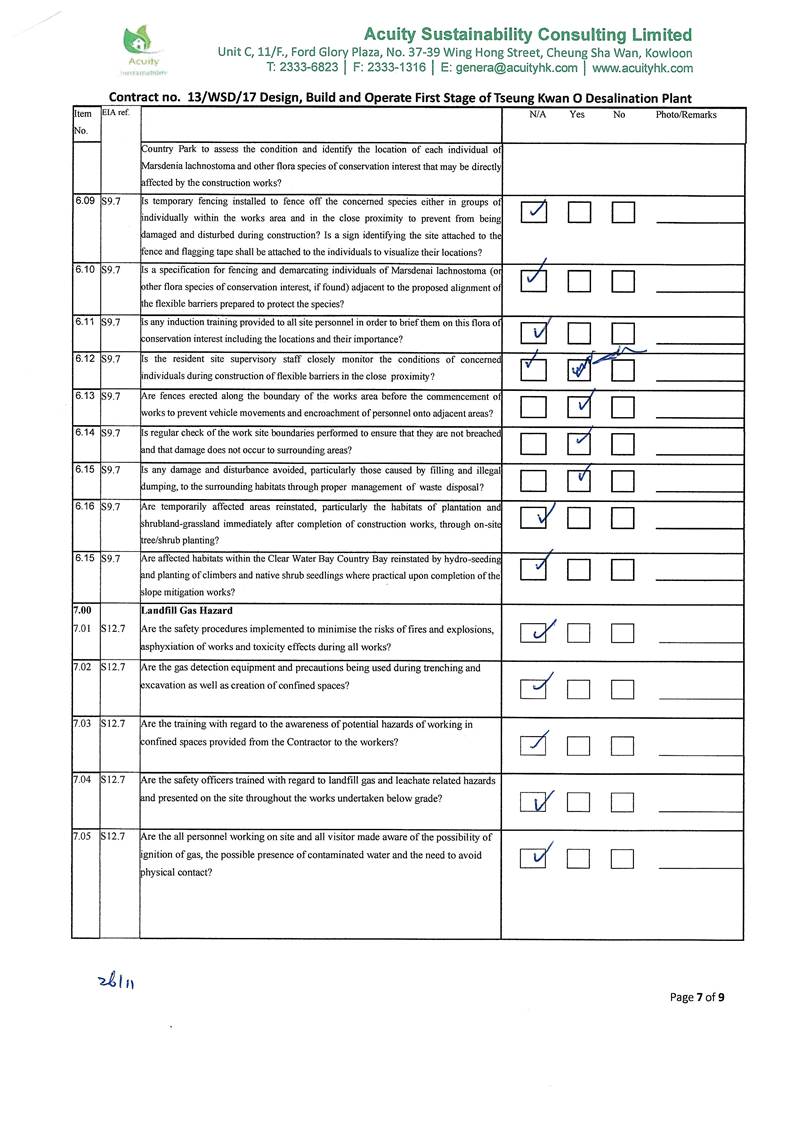
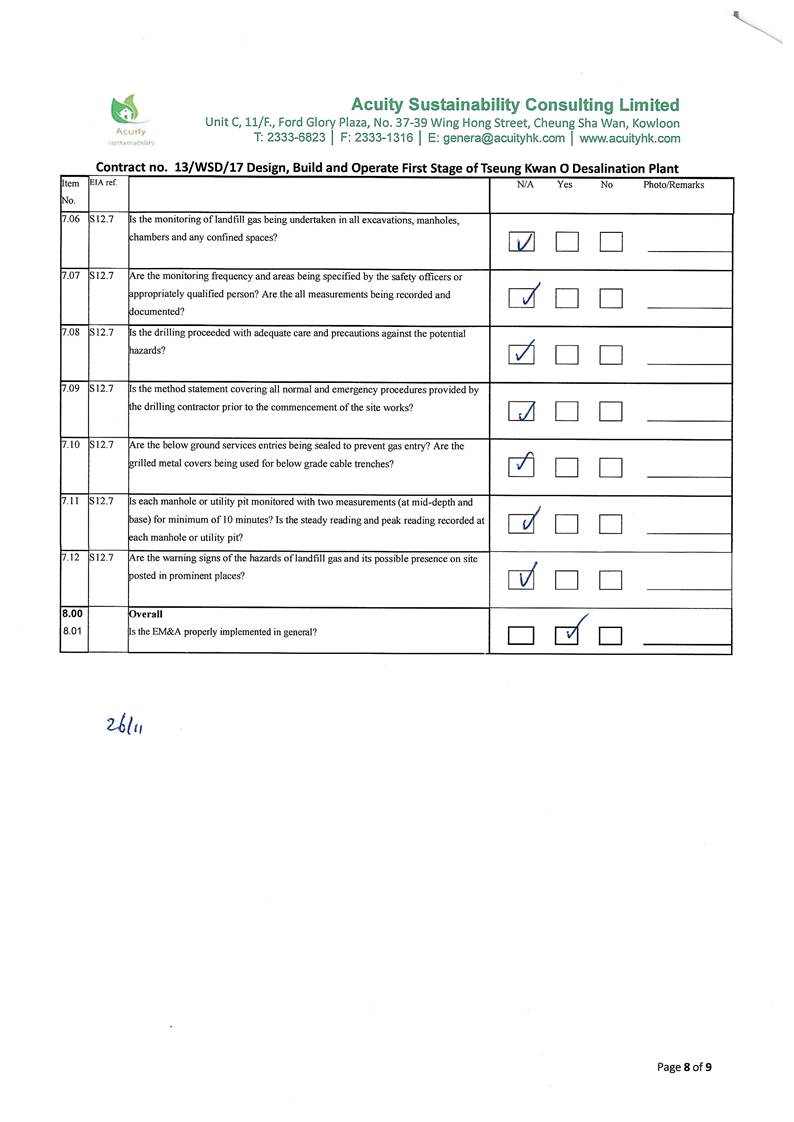
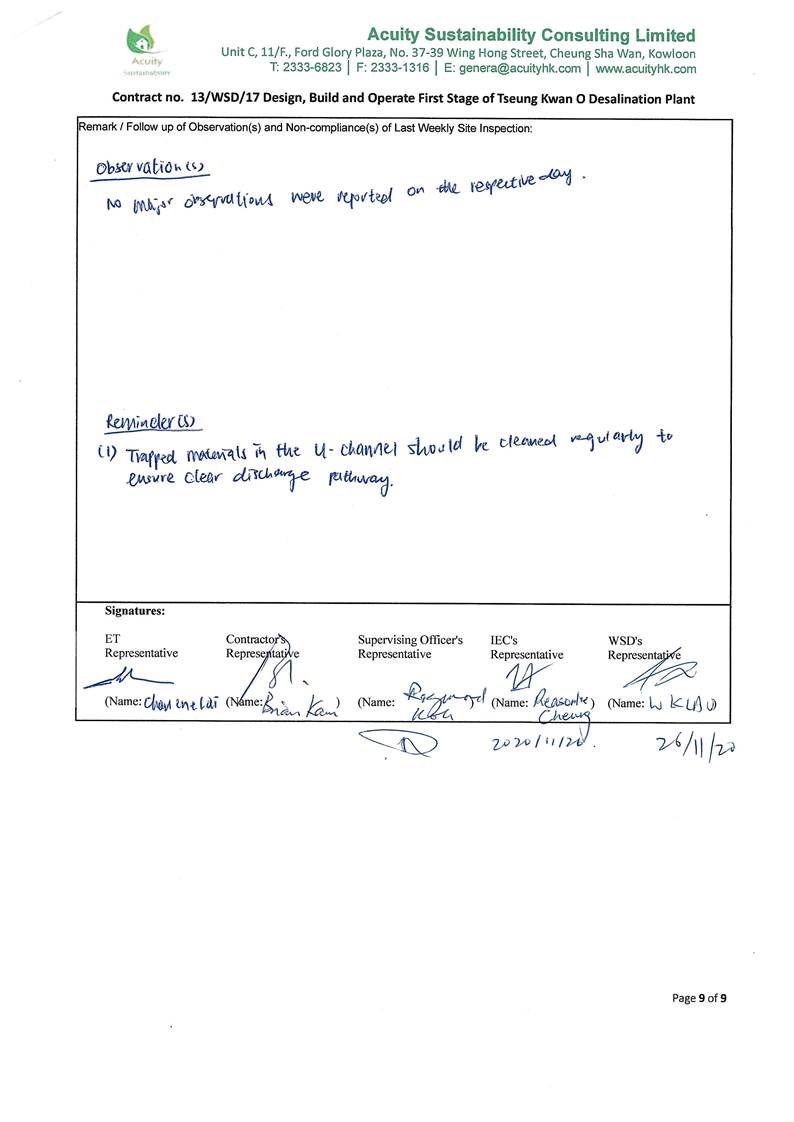
Appendix J
Complaint
Log
Statistical
Summary of Environmental Complaints
|
Reporting Period |
Environmental
Complaint Statistics |
||
|
Frequency |
Cumulative |
Complaint Nature |
|
|
01 Nov 2020 - 30 Nov 2020 |
0 |
0 |
N/A |
Statistical
Summary of Environmental Summons
|
Reporting Period |
Environmental
Summons Statistics |
||
|
Frequency |
Cumulative |
Details |
|
|
01 Nov 2020 - 30 Nov 2020 |
0 |
0 |
N/A |
Statistical
Summary of Environmental Prosecution
|
Reporting Period |
Environmental
Prosecution Statistics |
||
|
Frequency |
Cumulative |
Details |
|
|
01 Nov 2020 - 30 Nov 2020 |
0 |
0 |
N/A |
Impact Monitoring Schedule of Next
Reporting Month (BLANK)